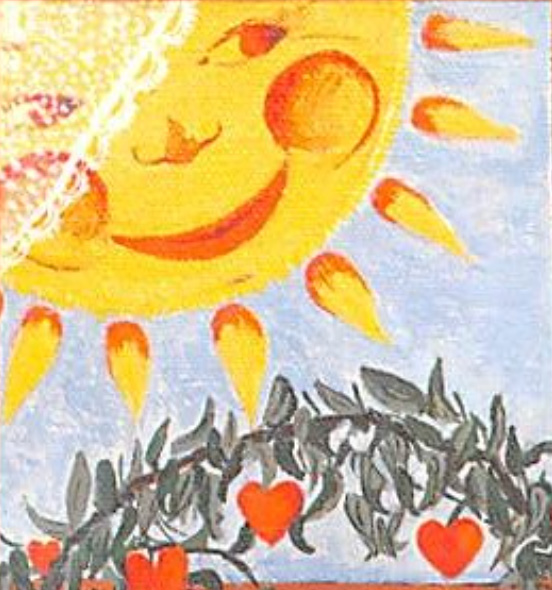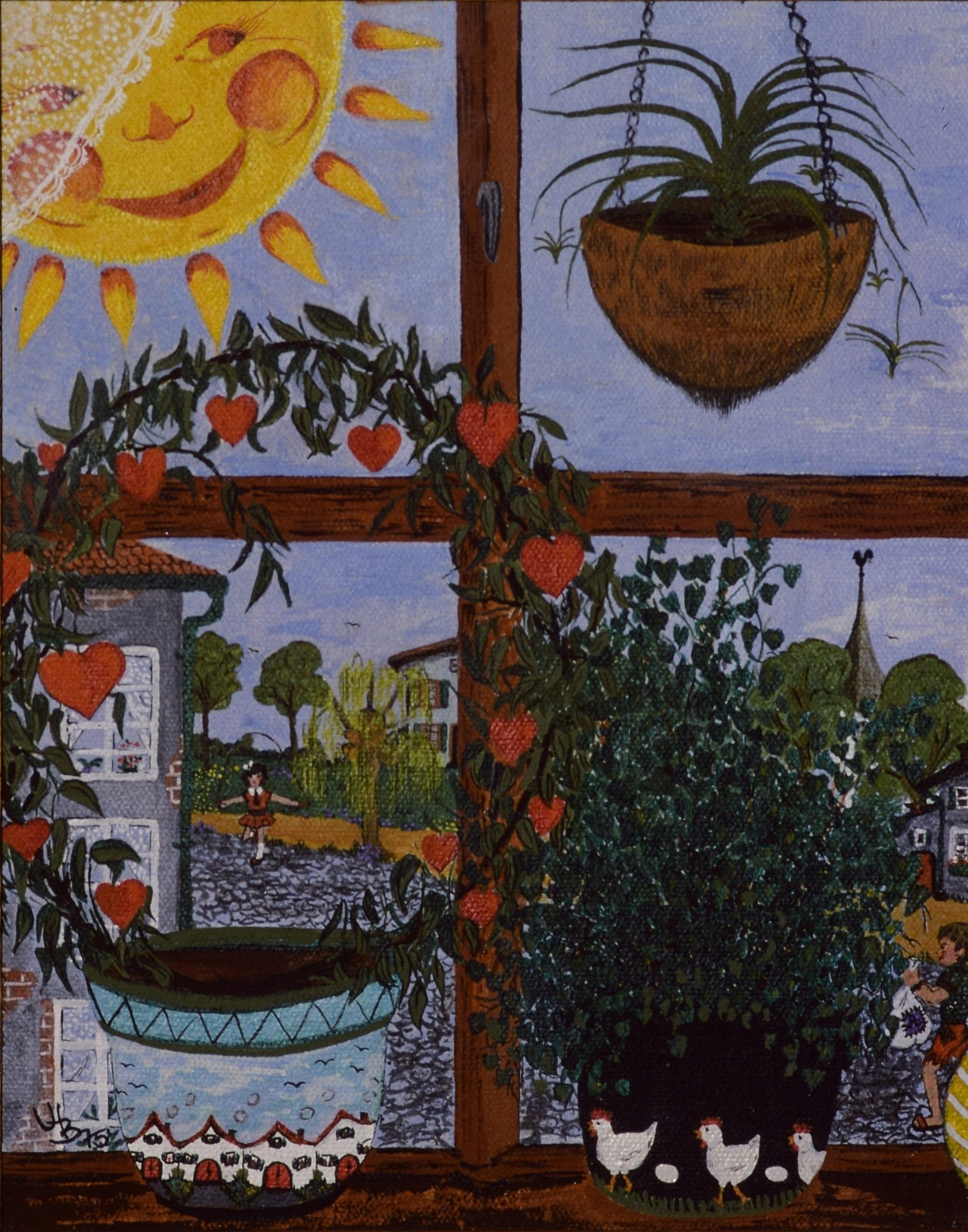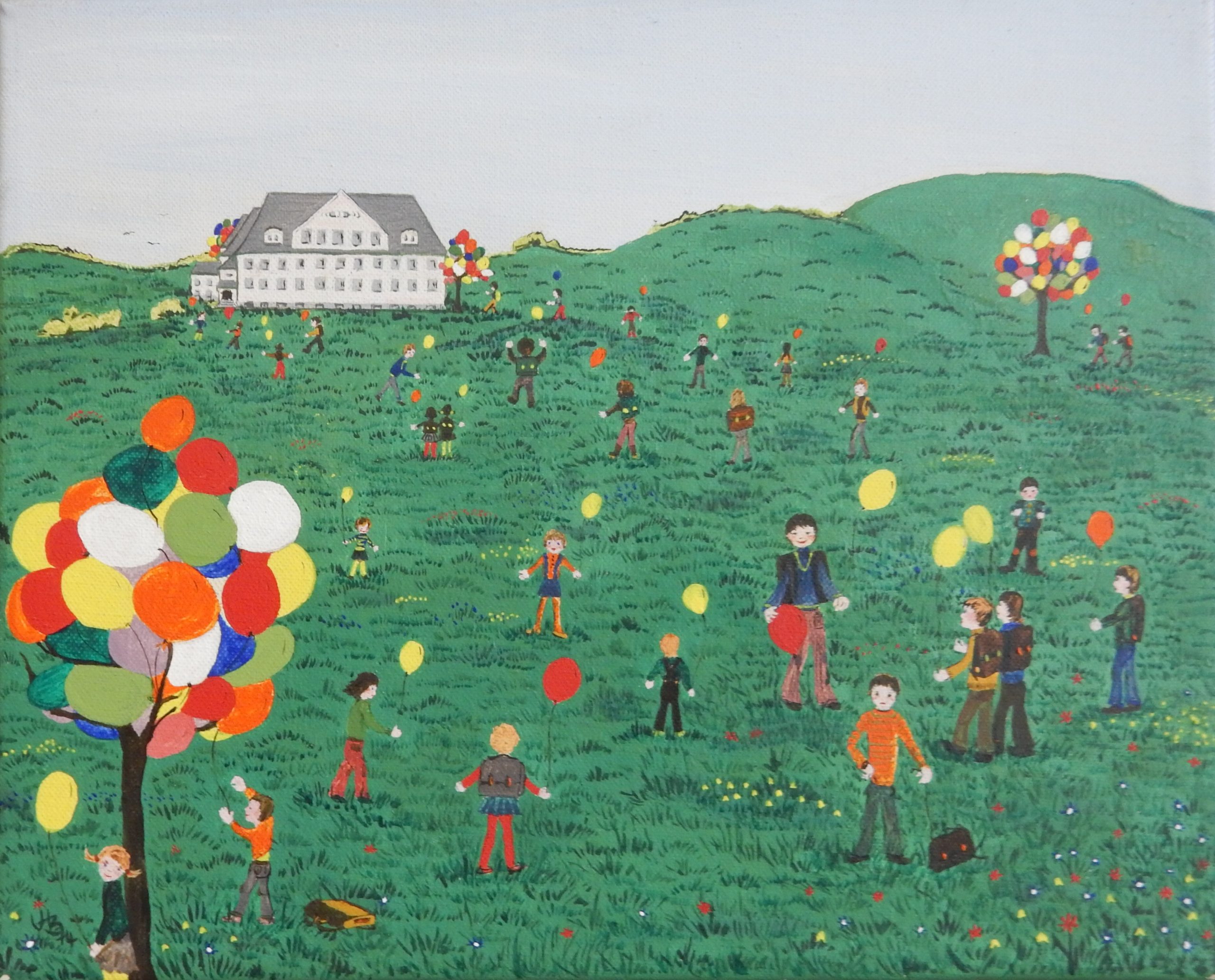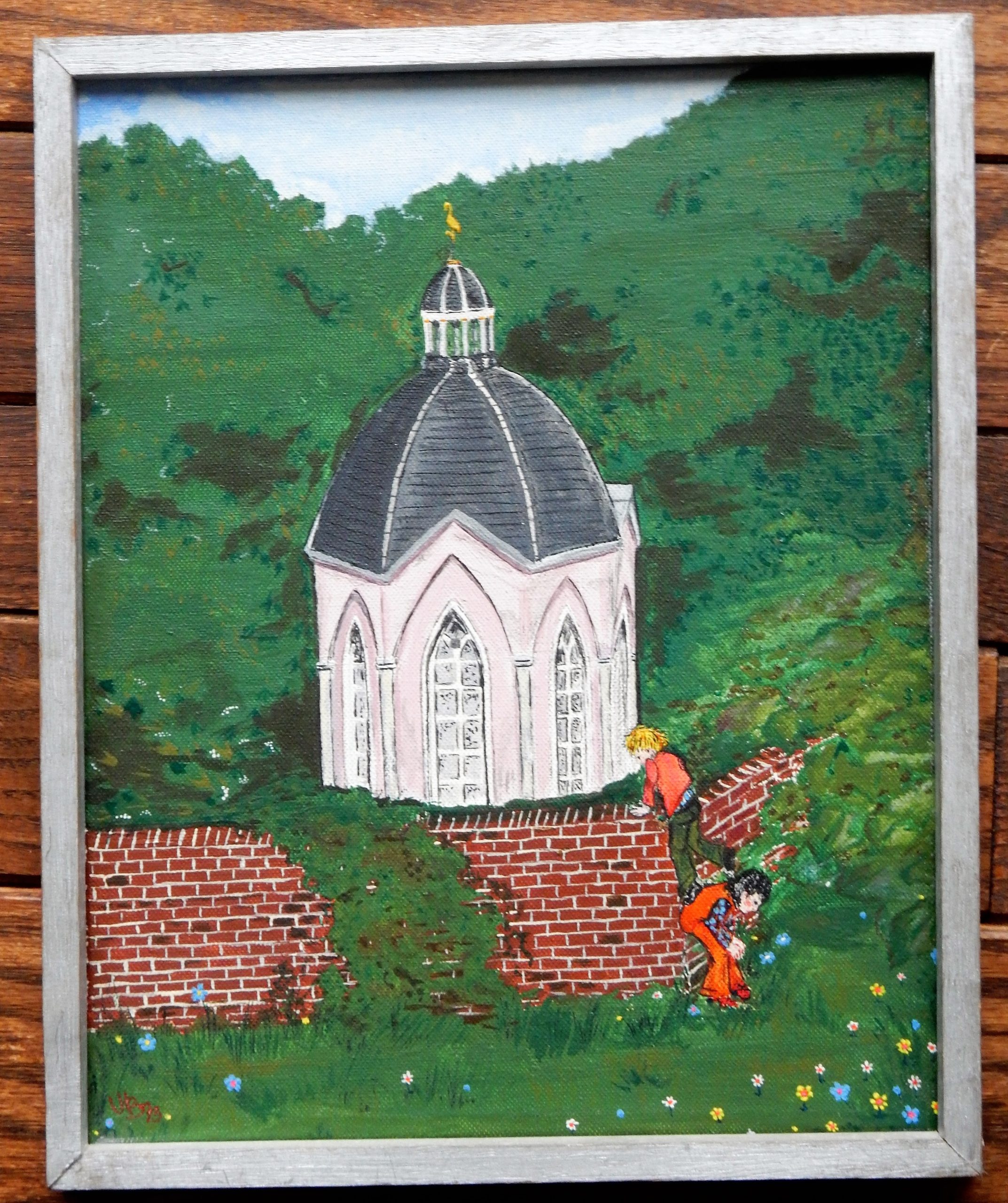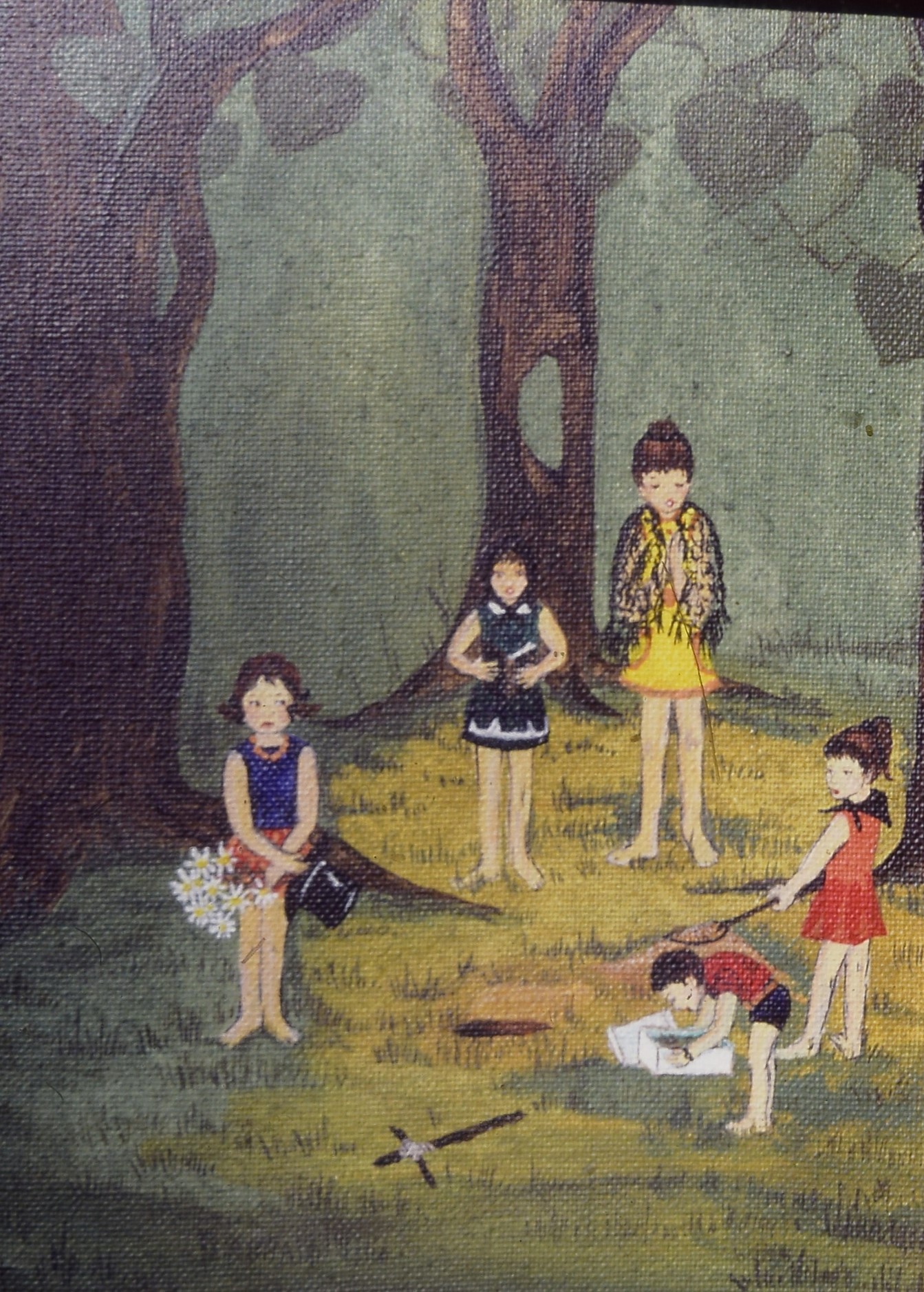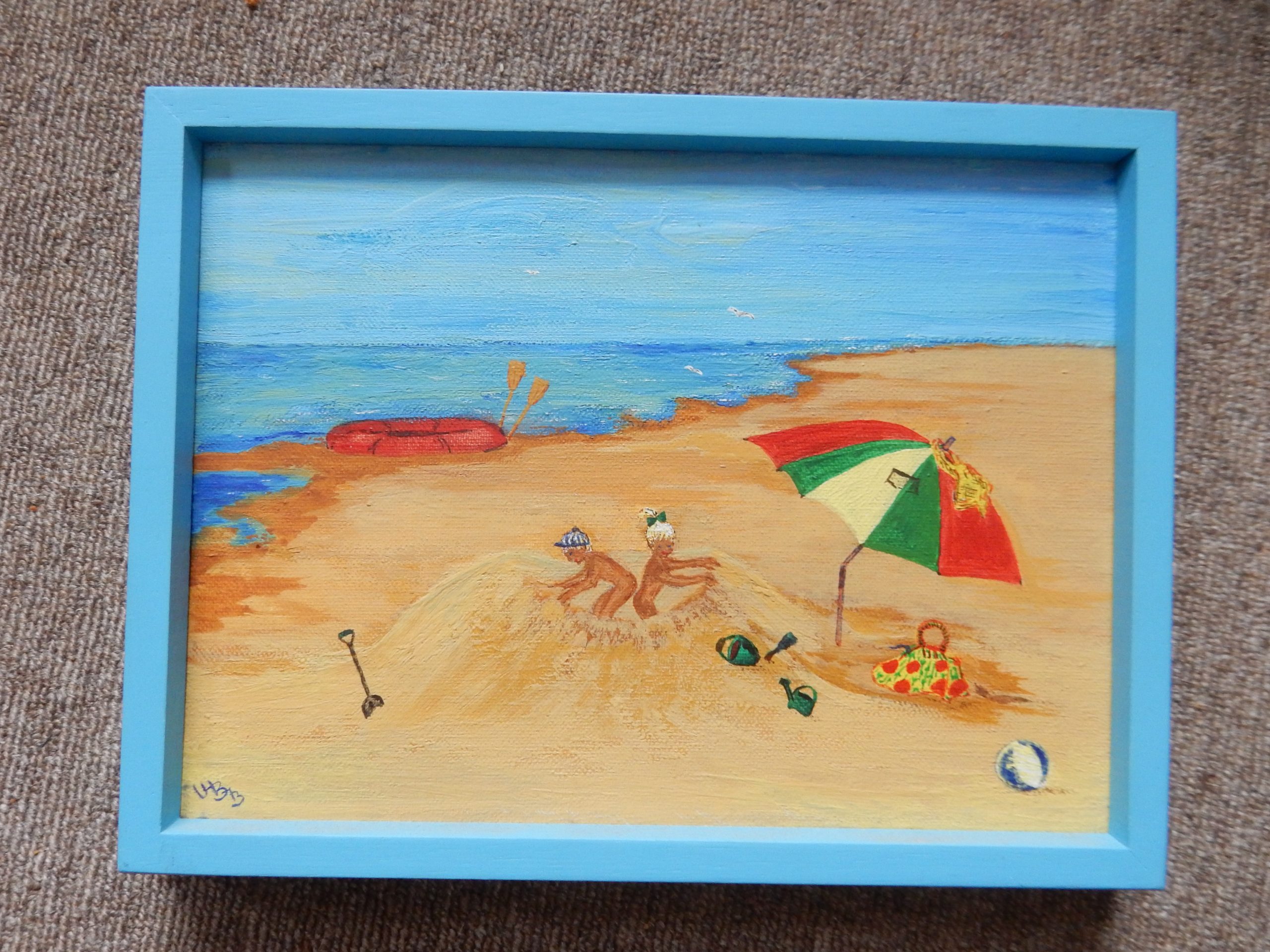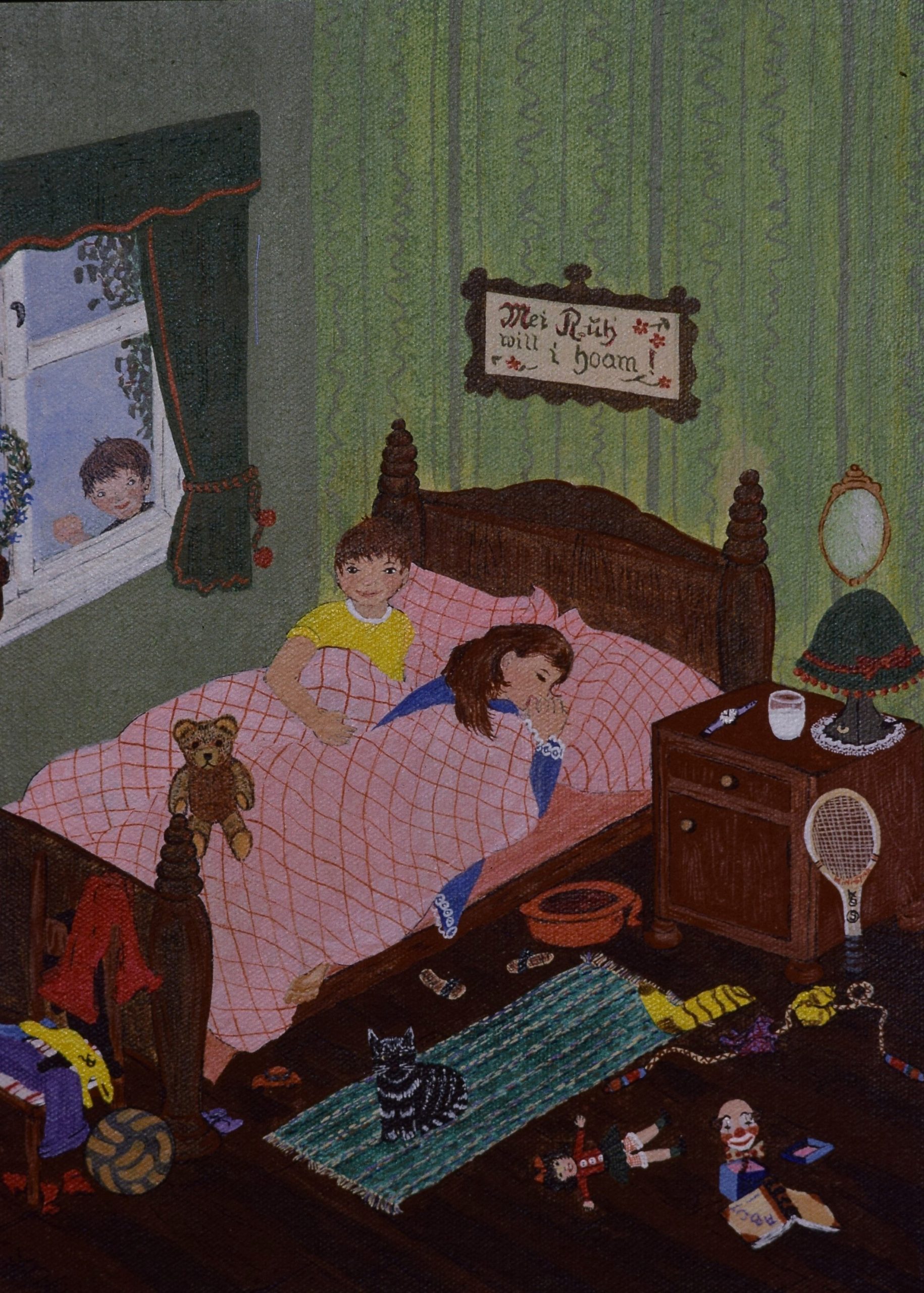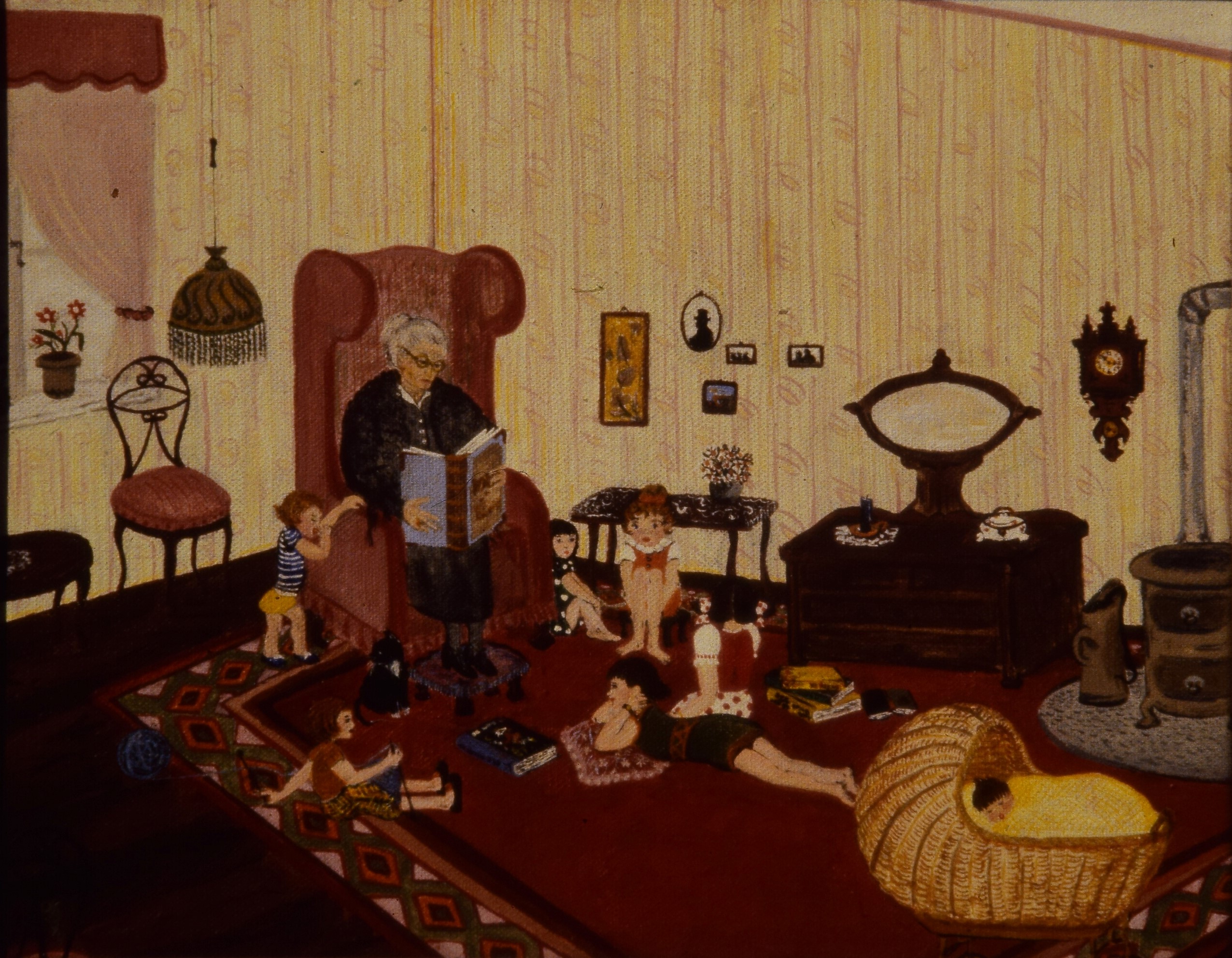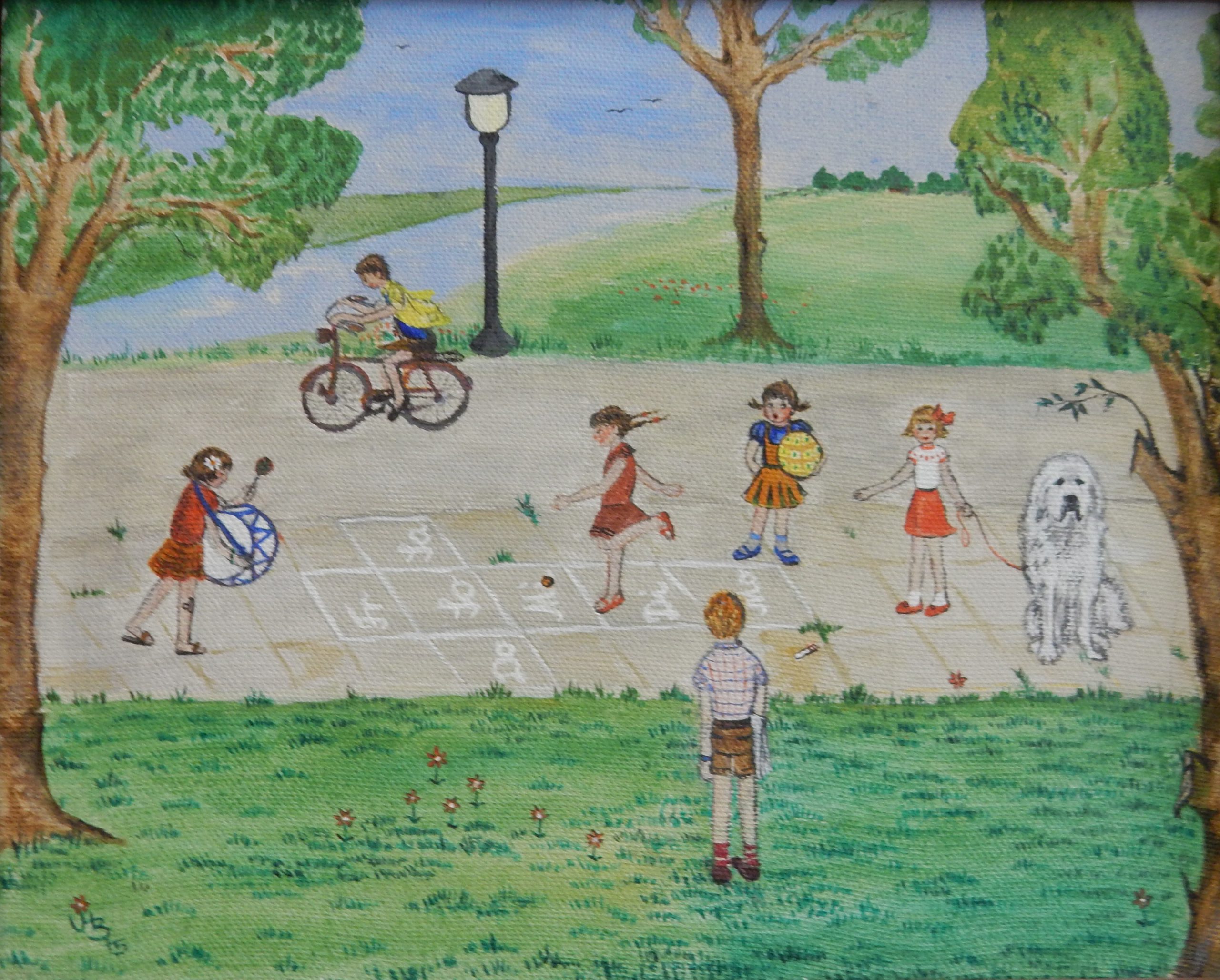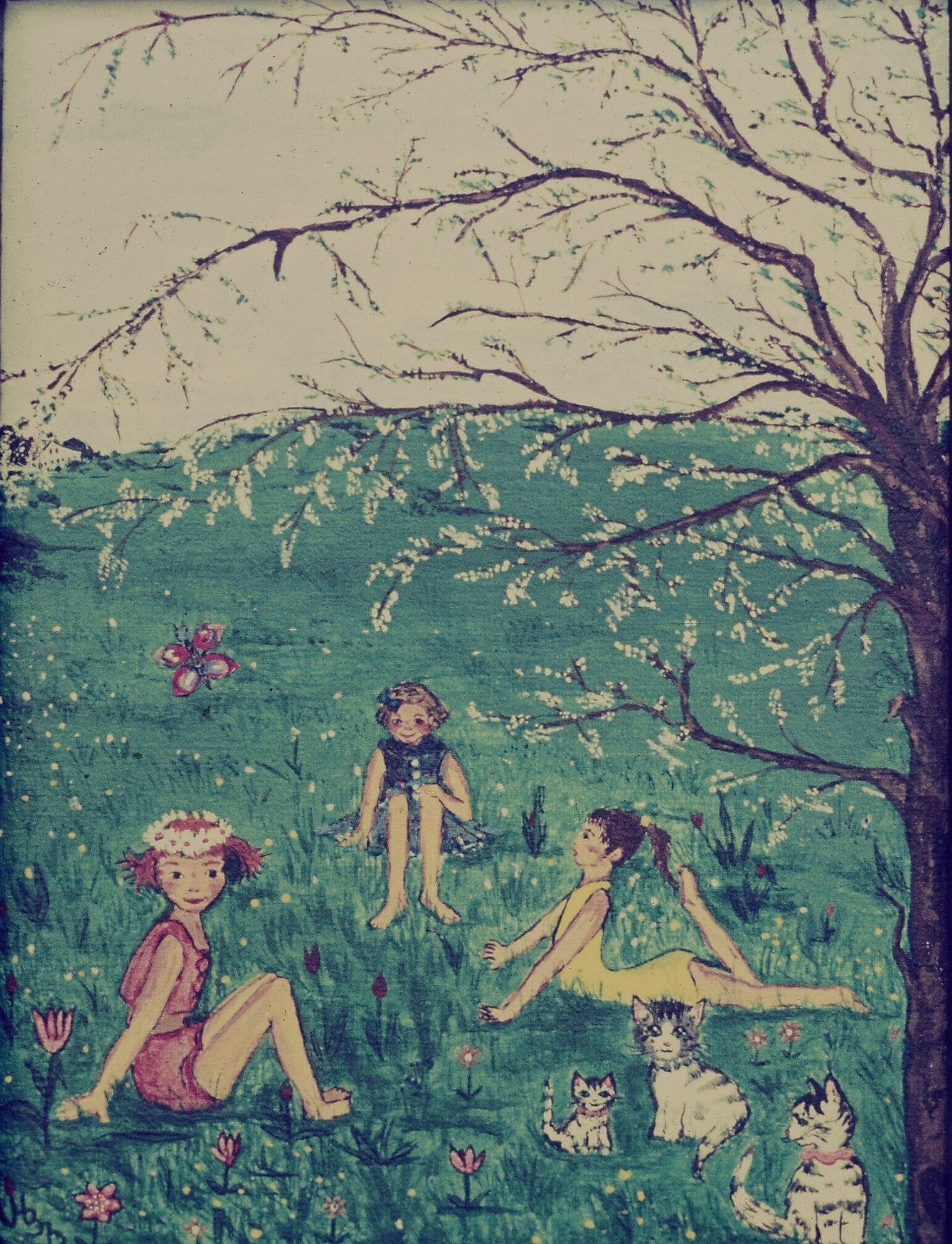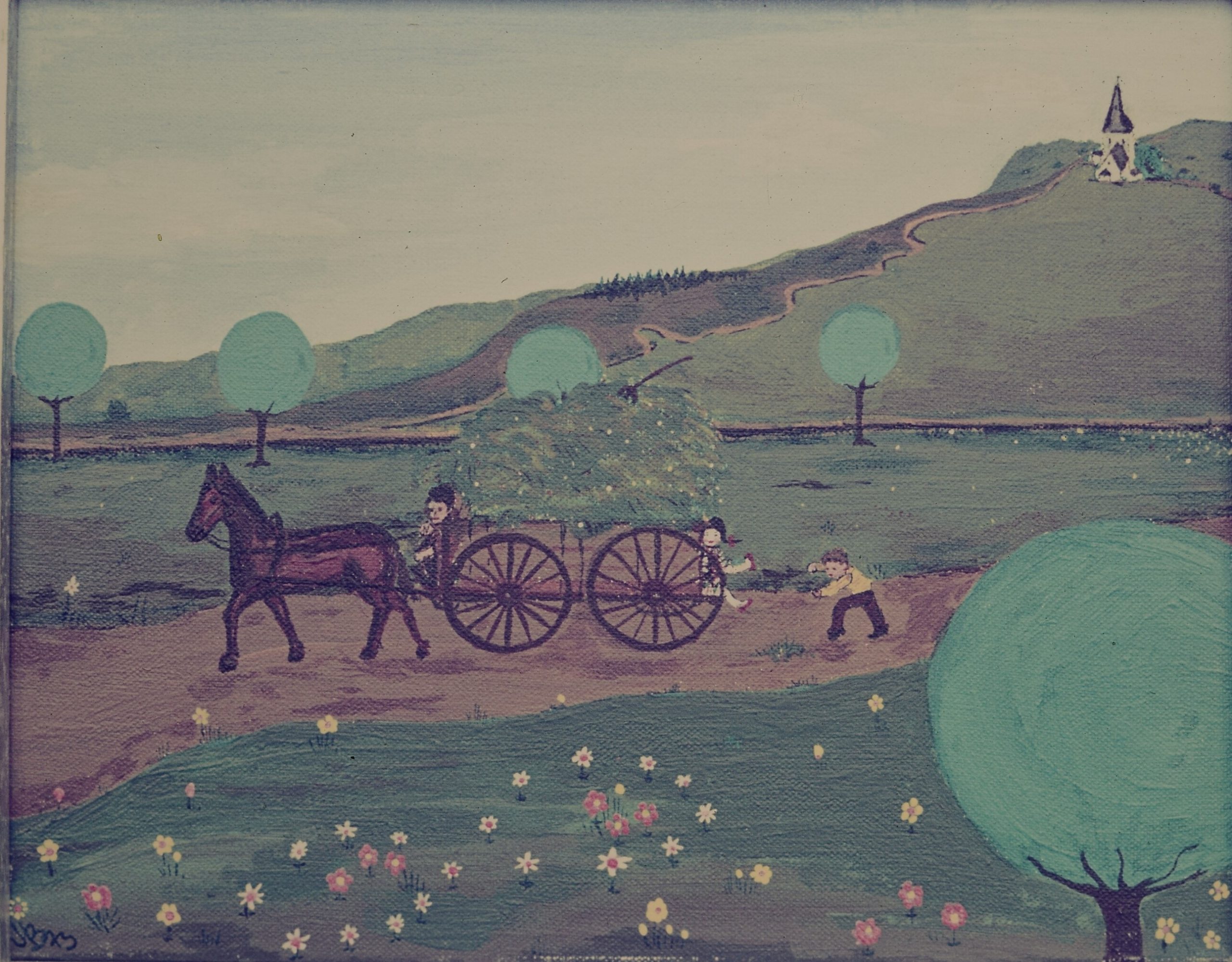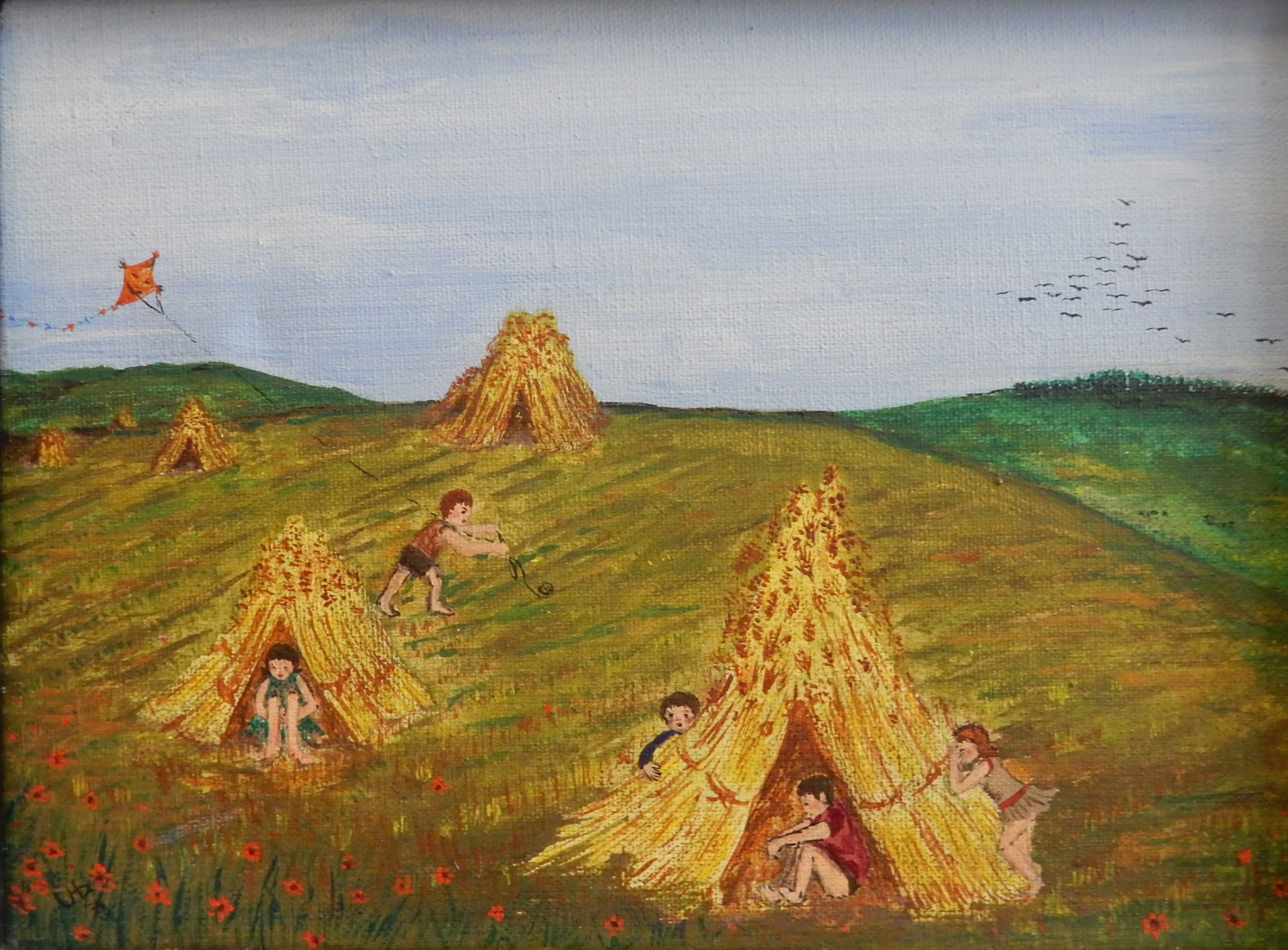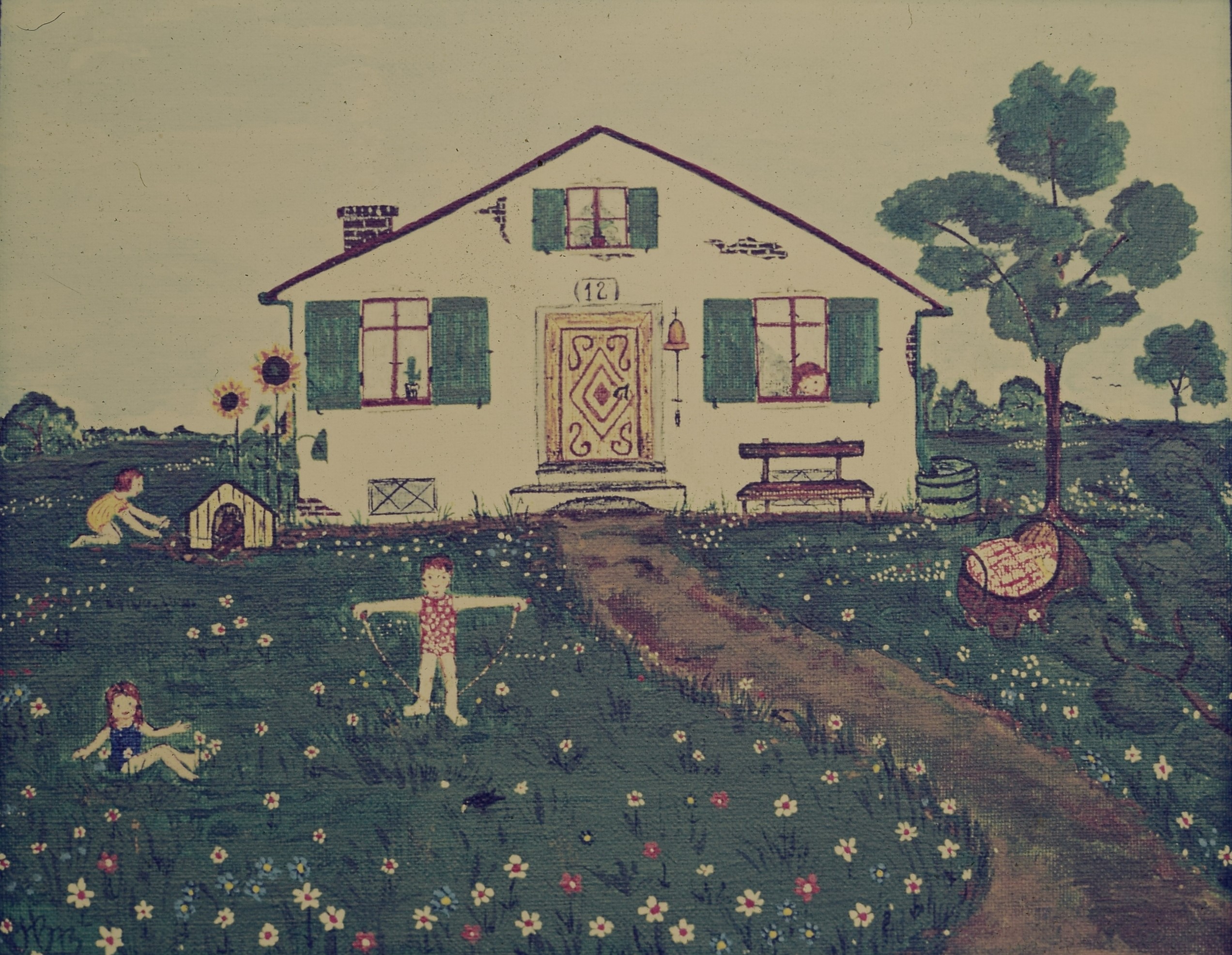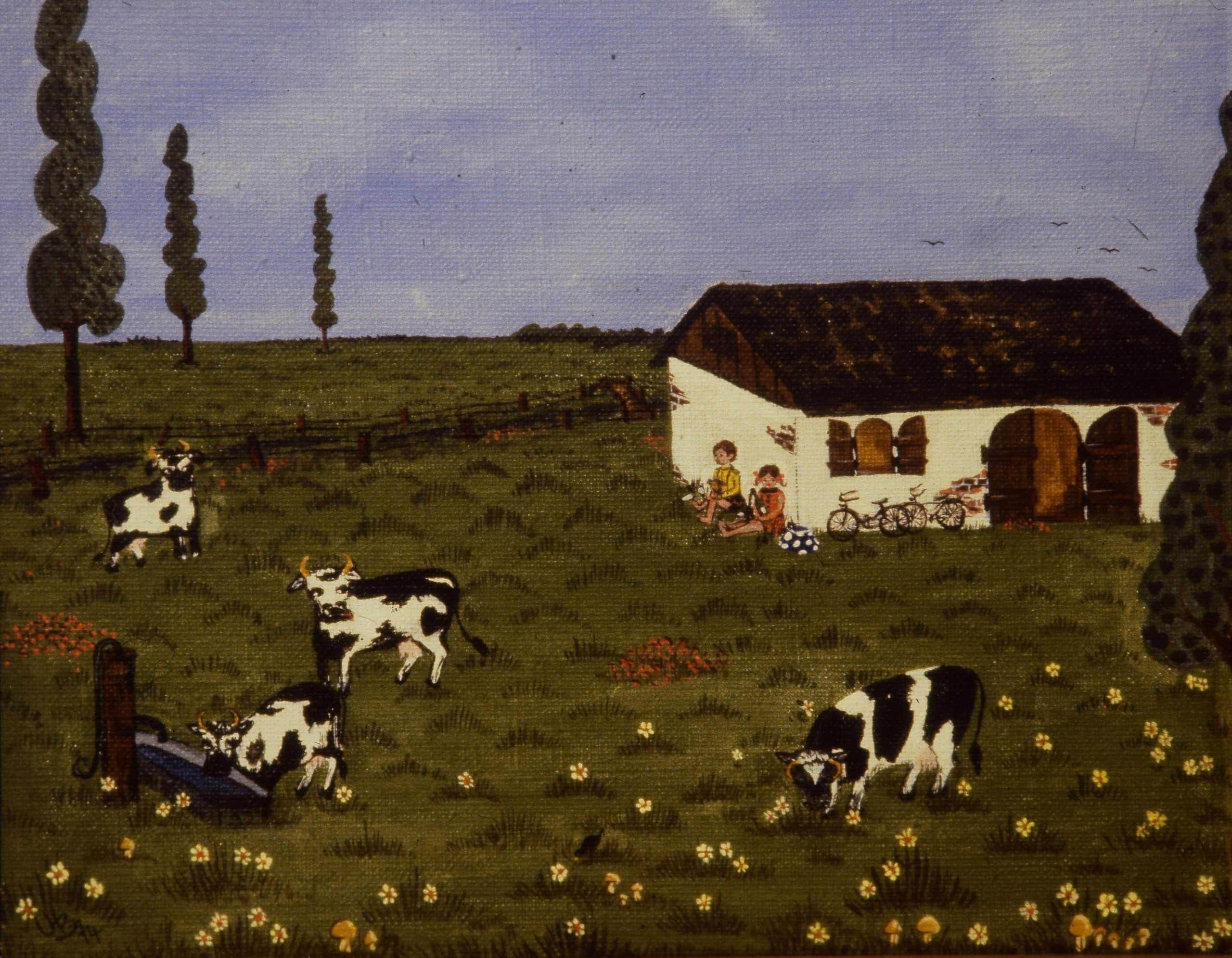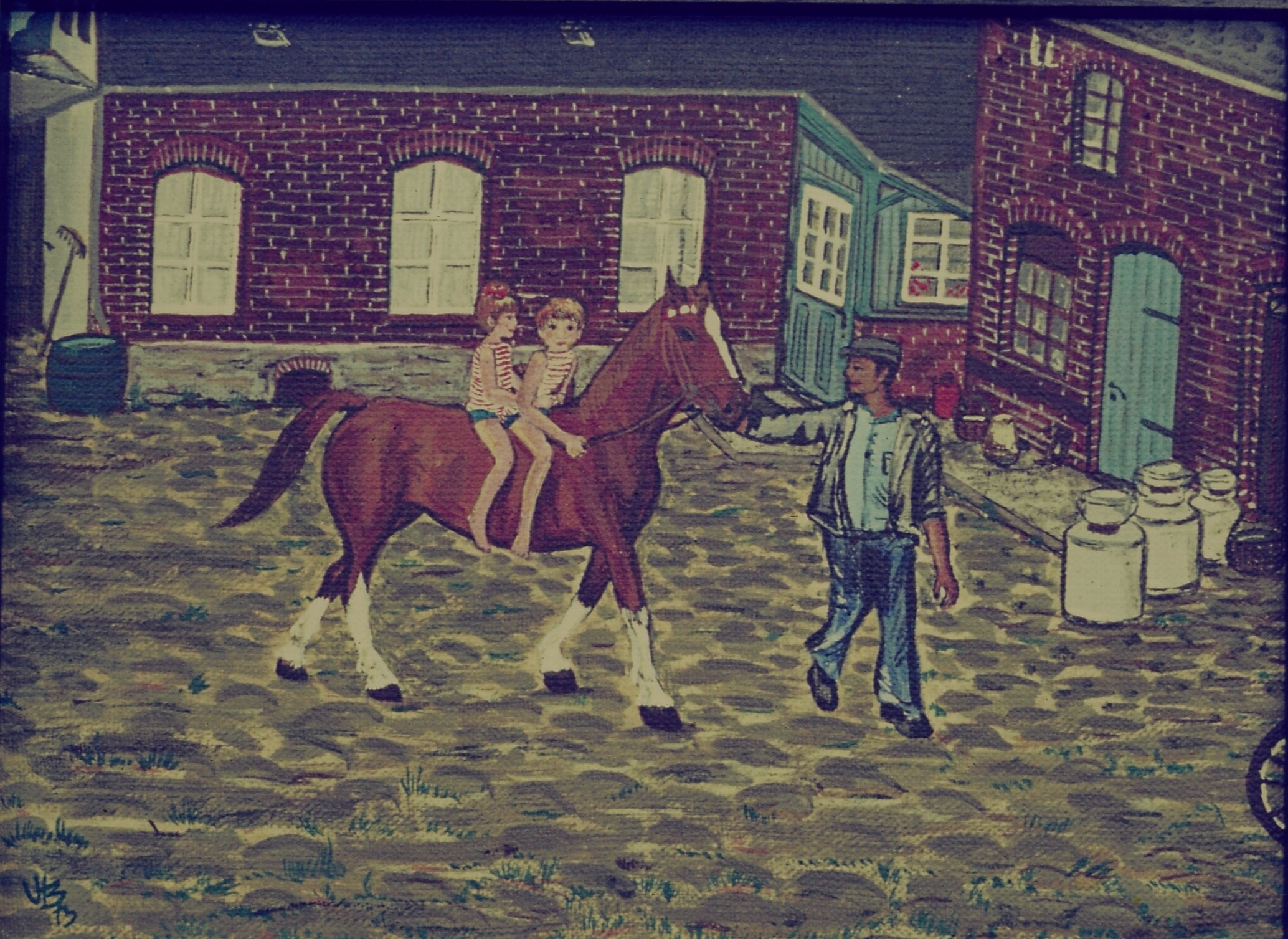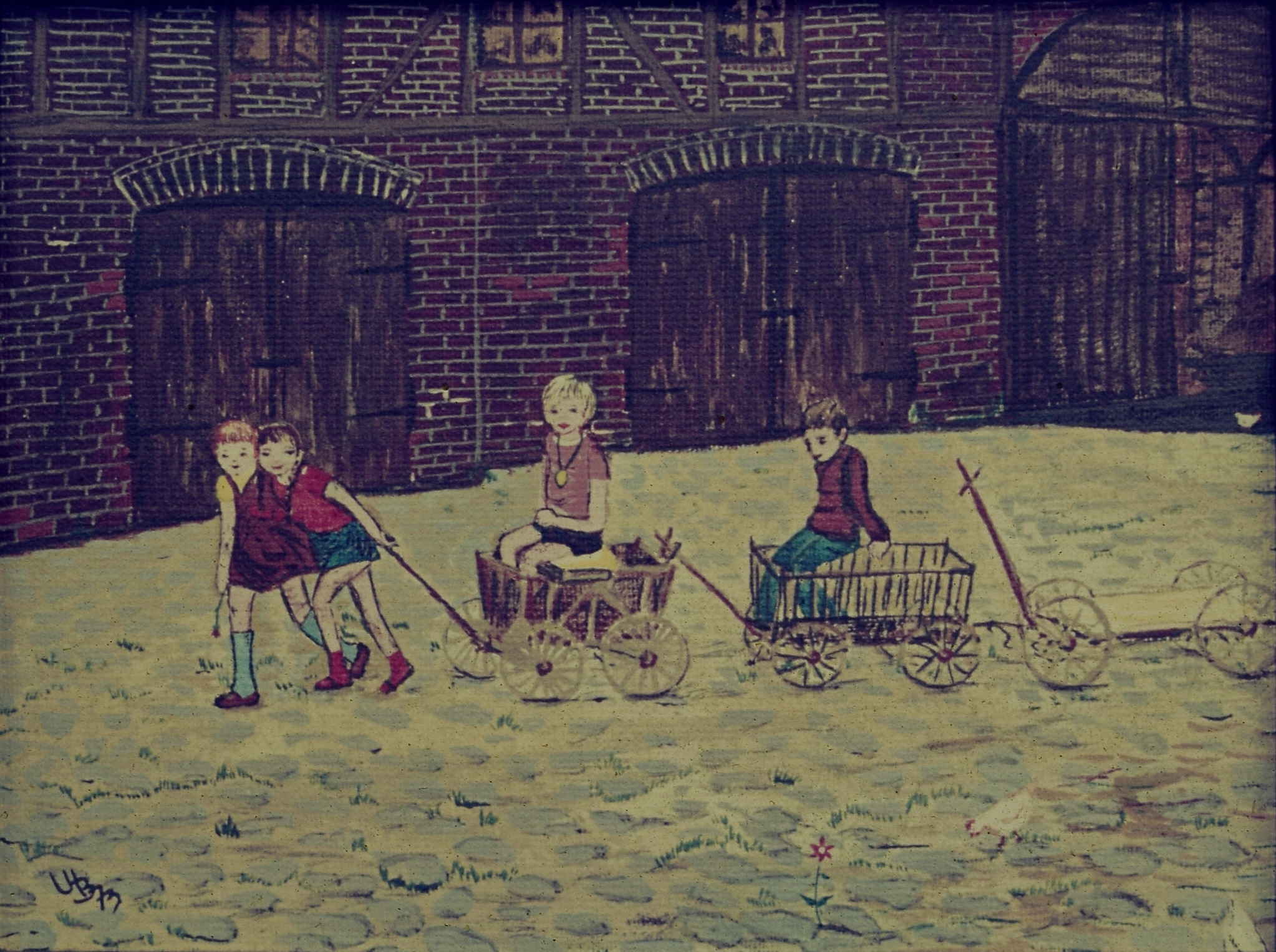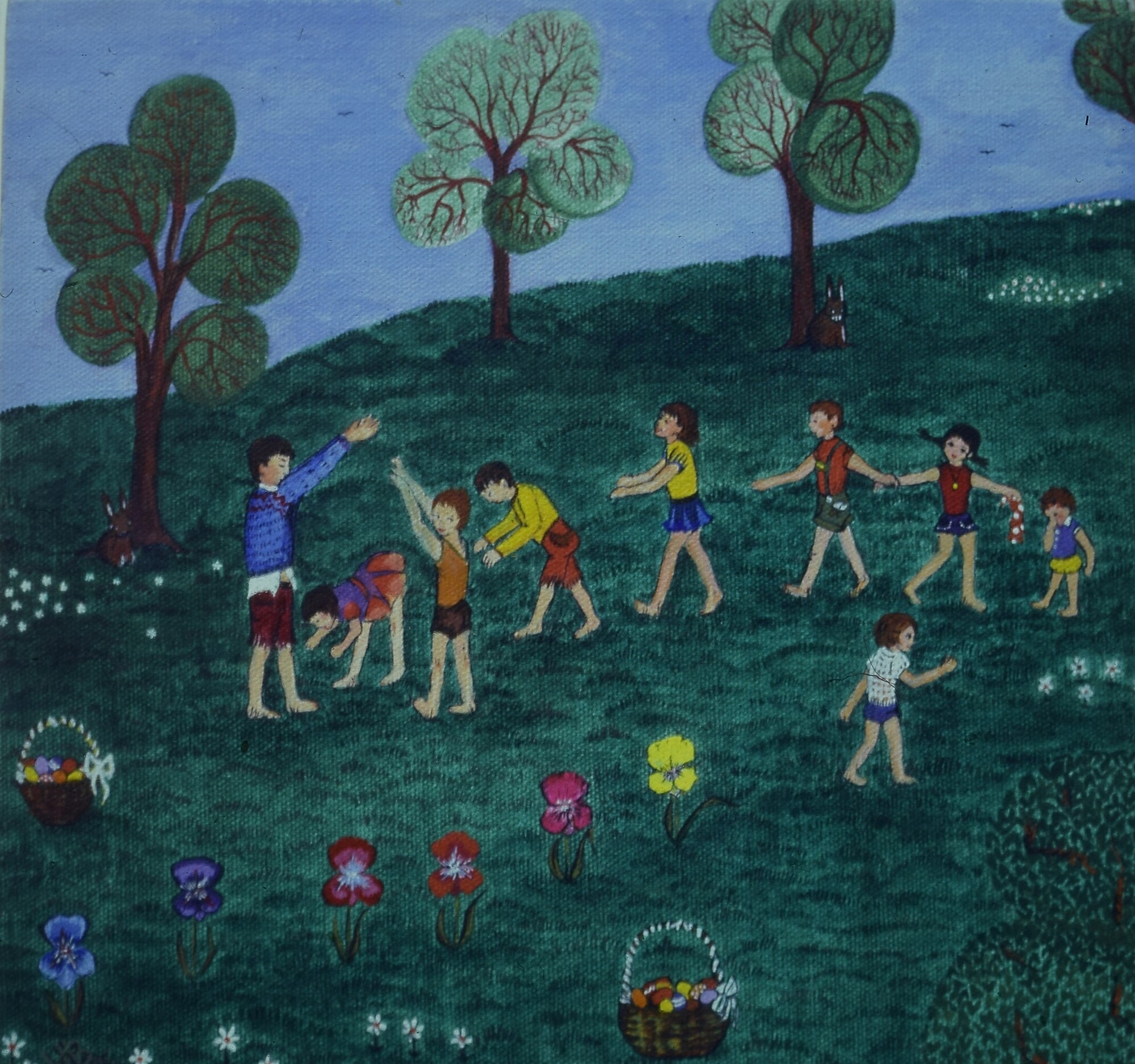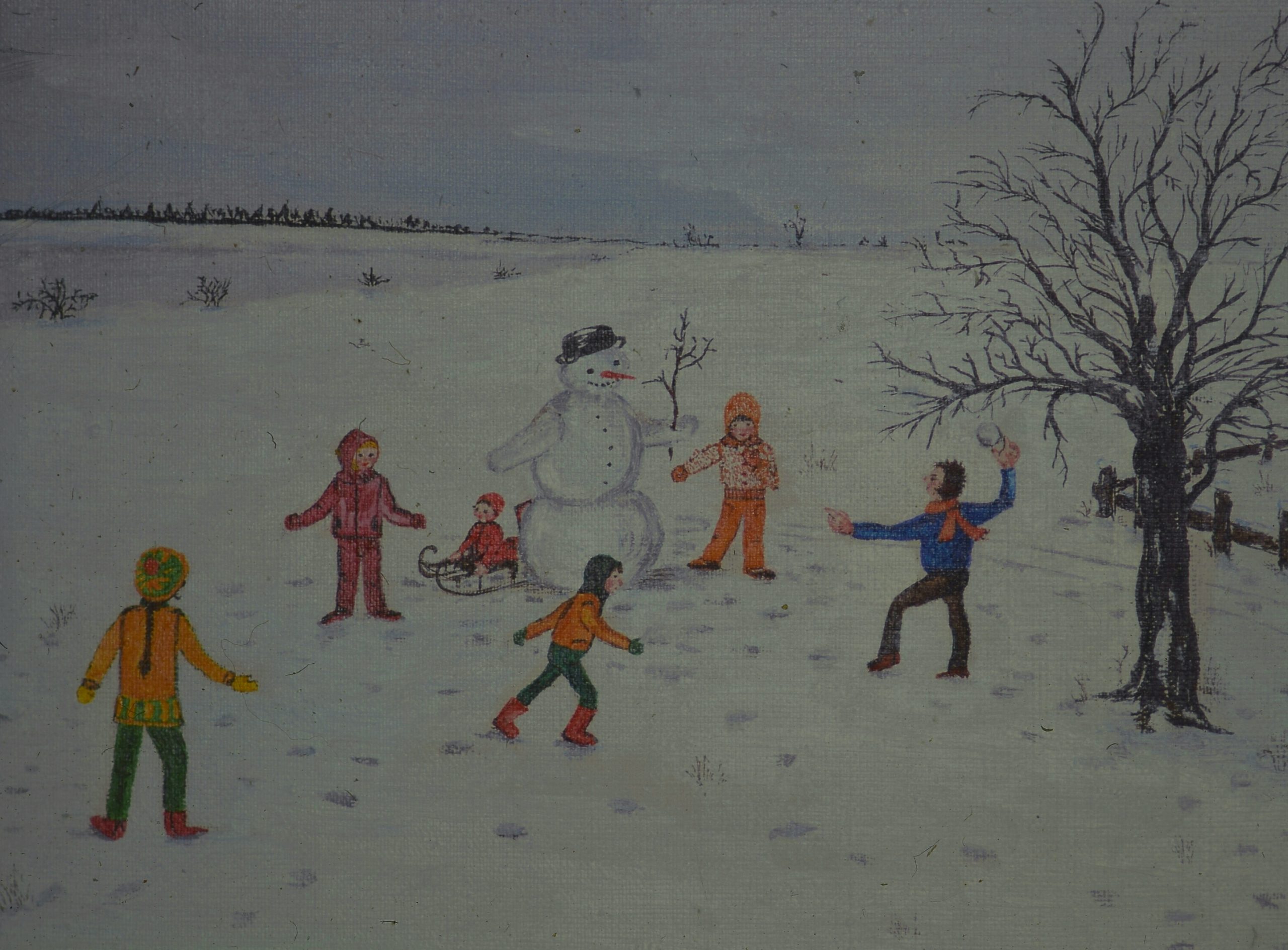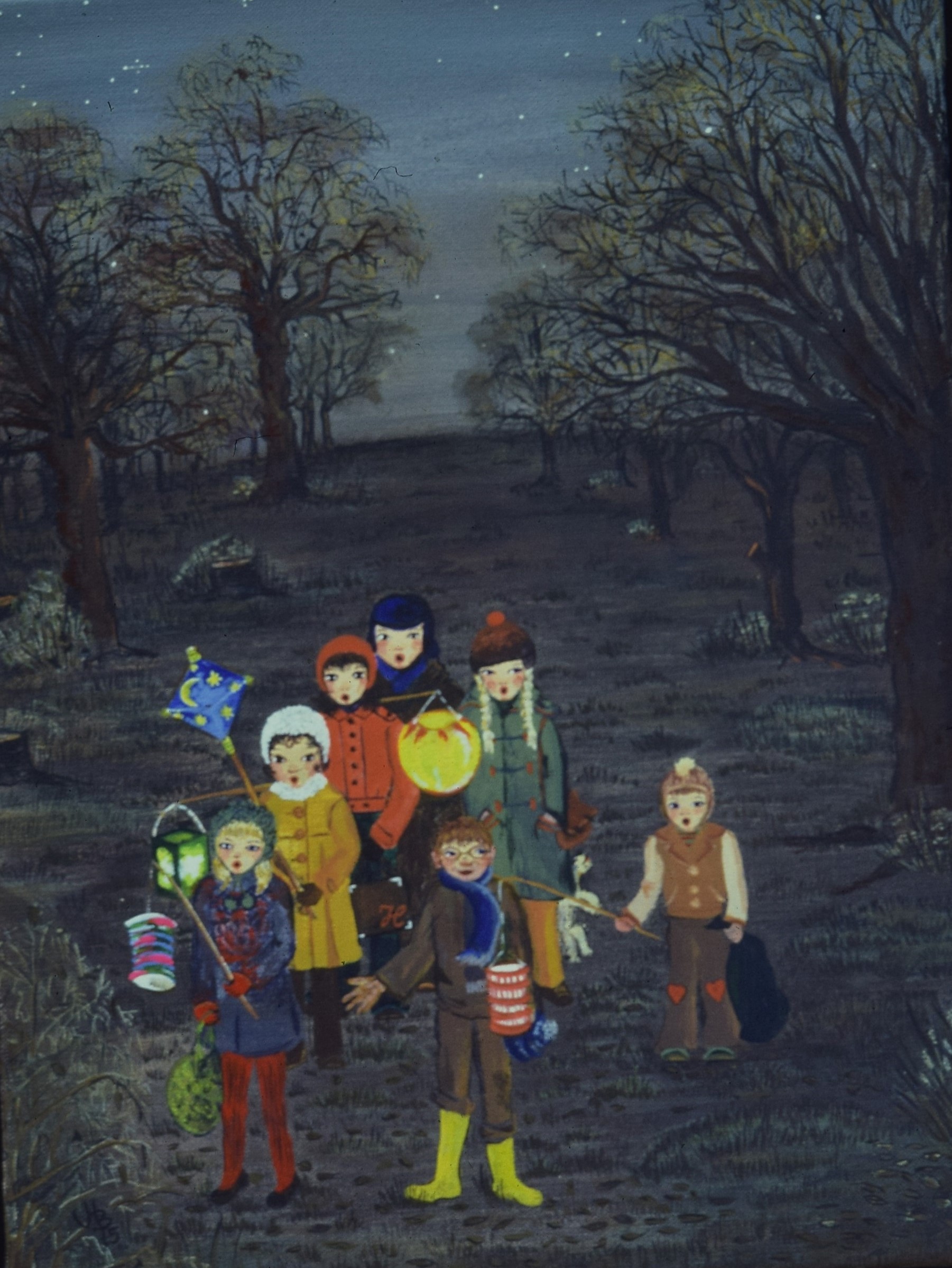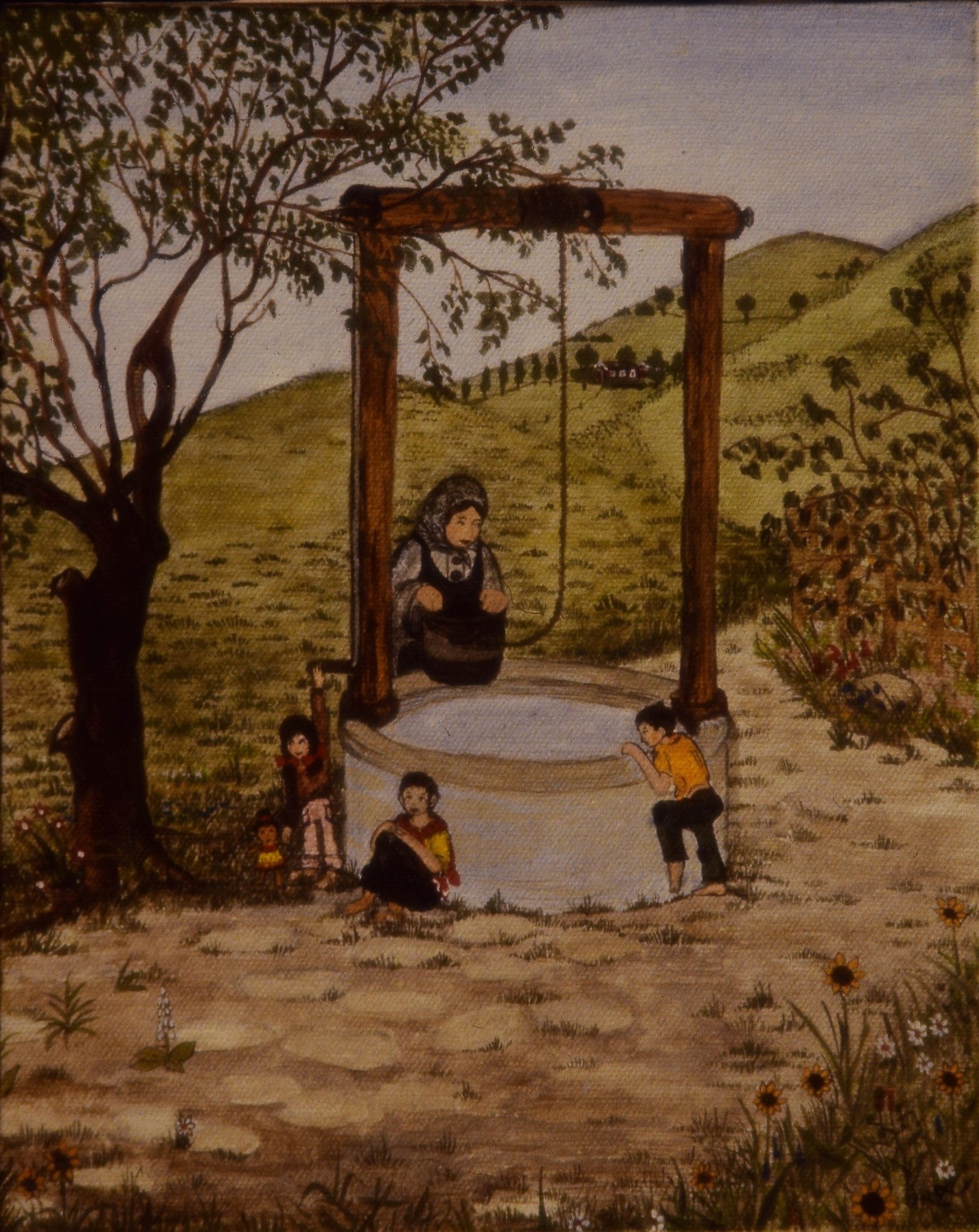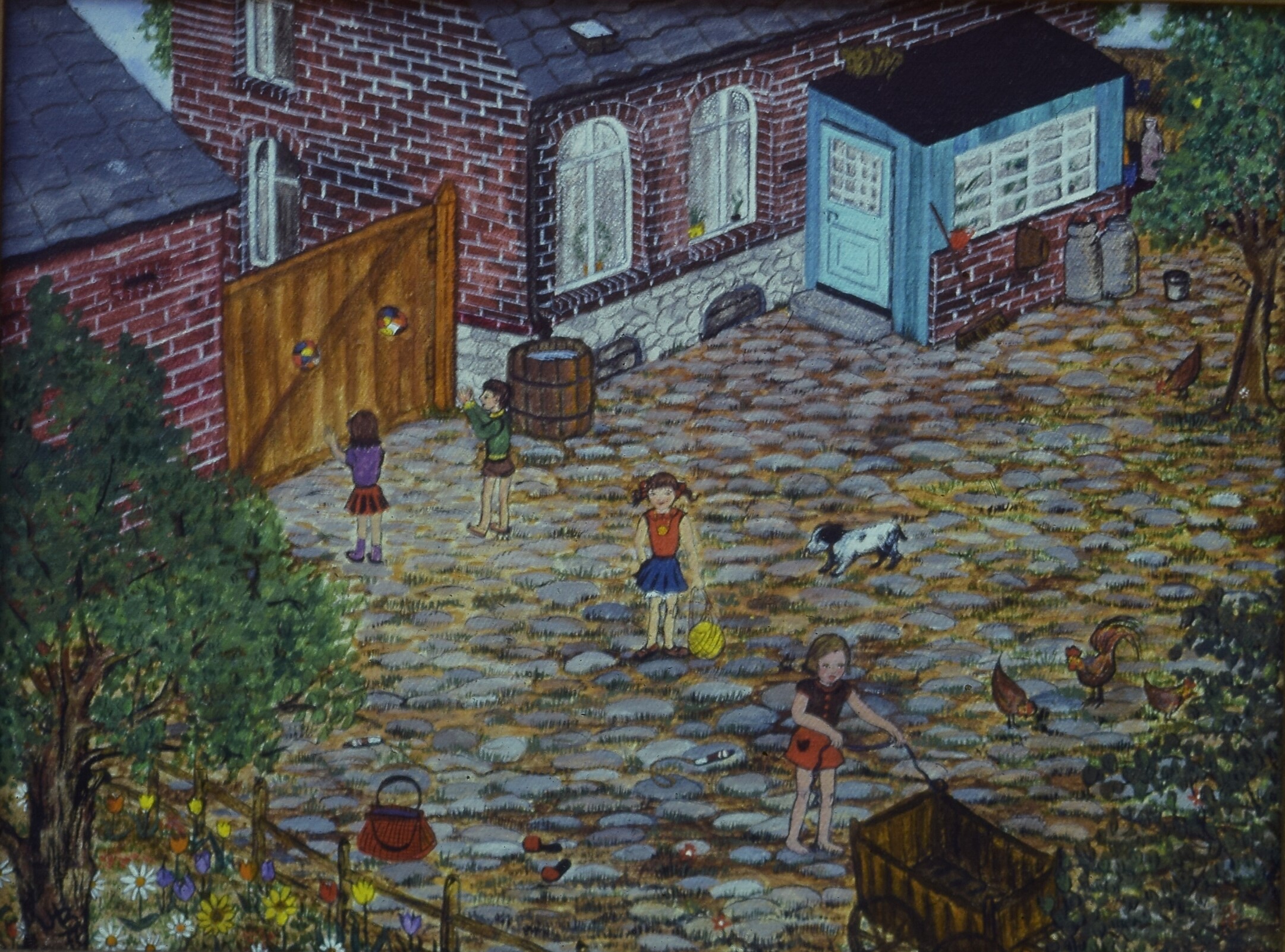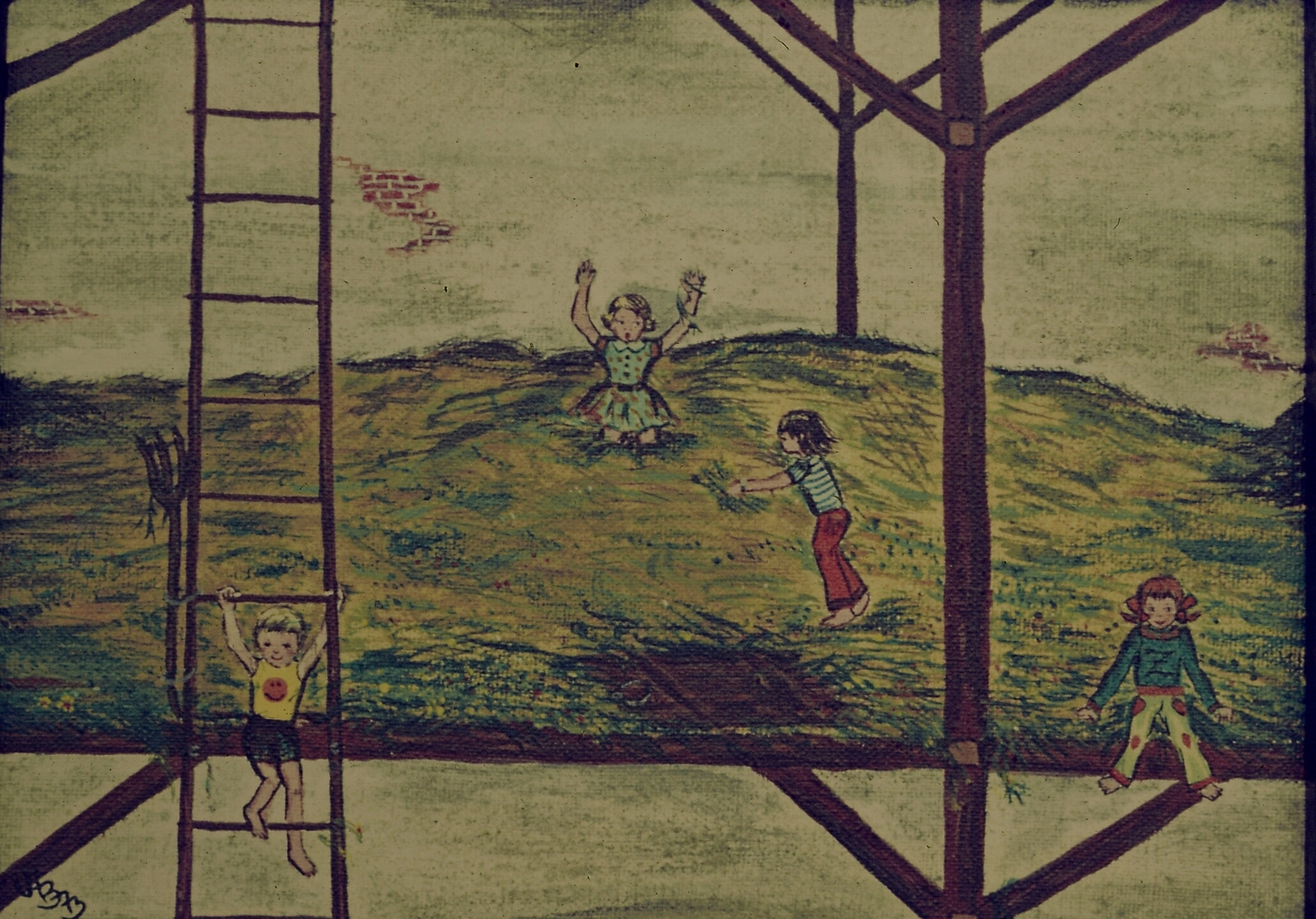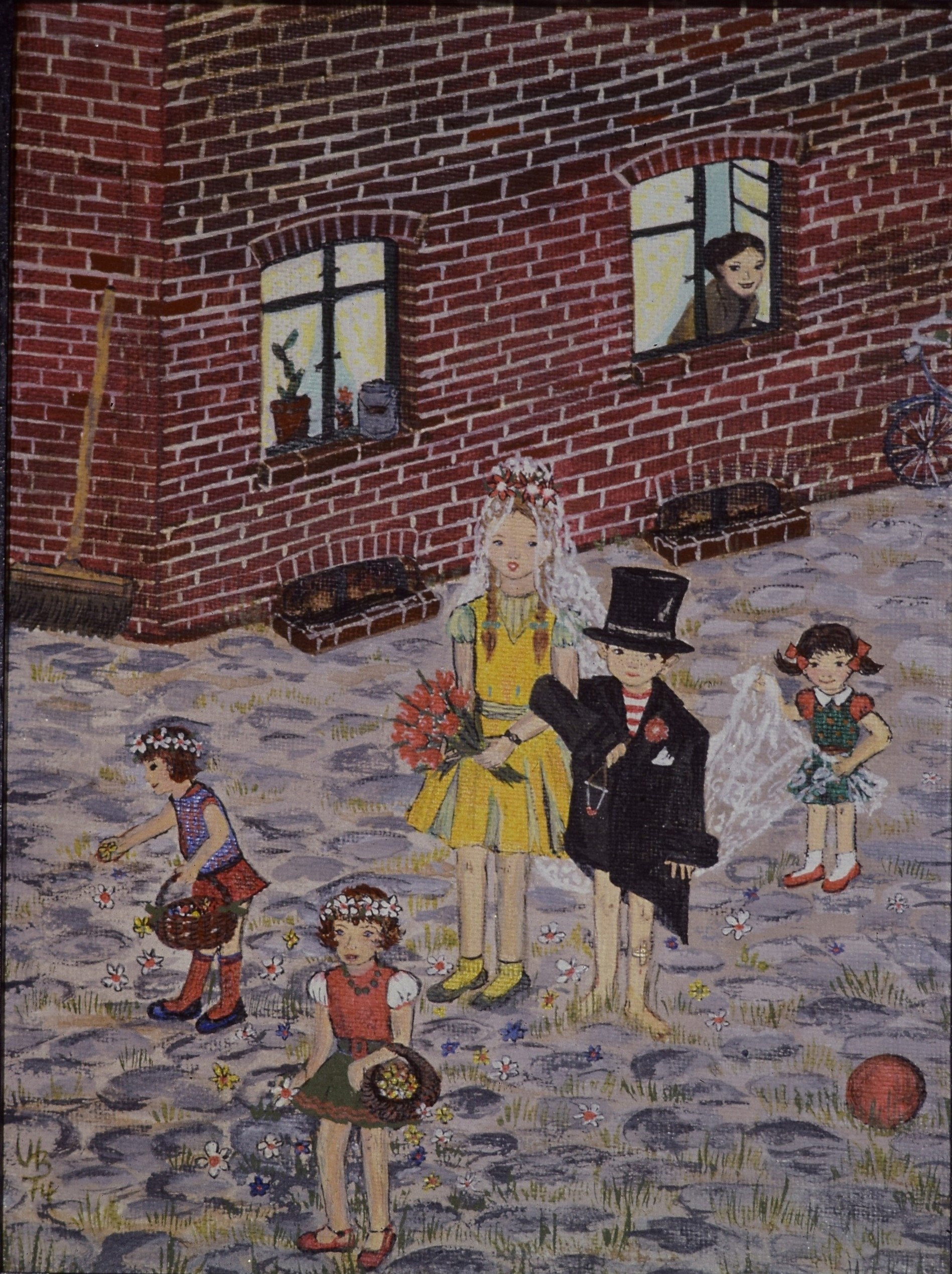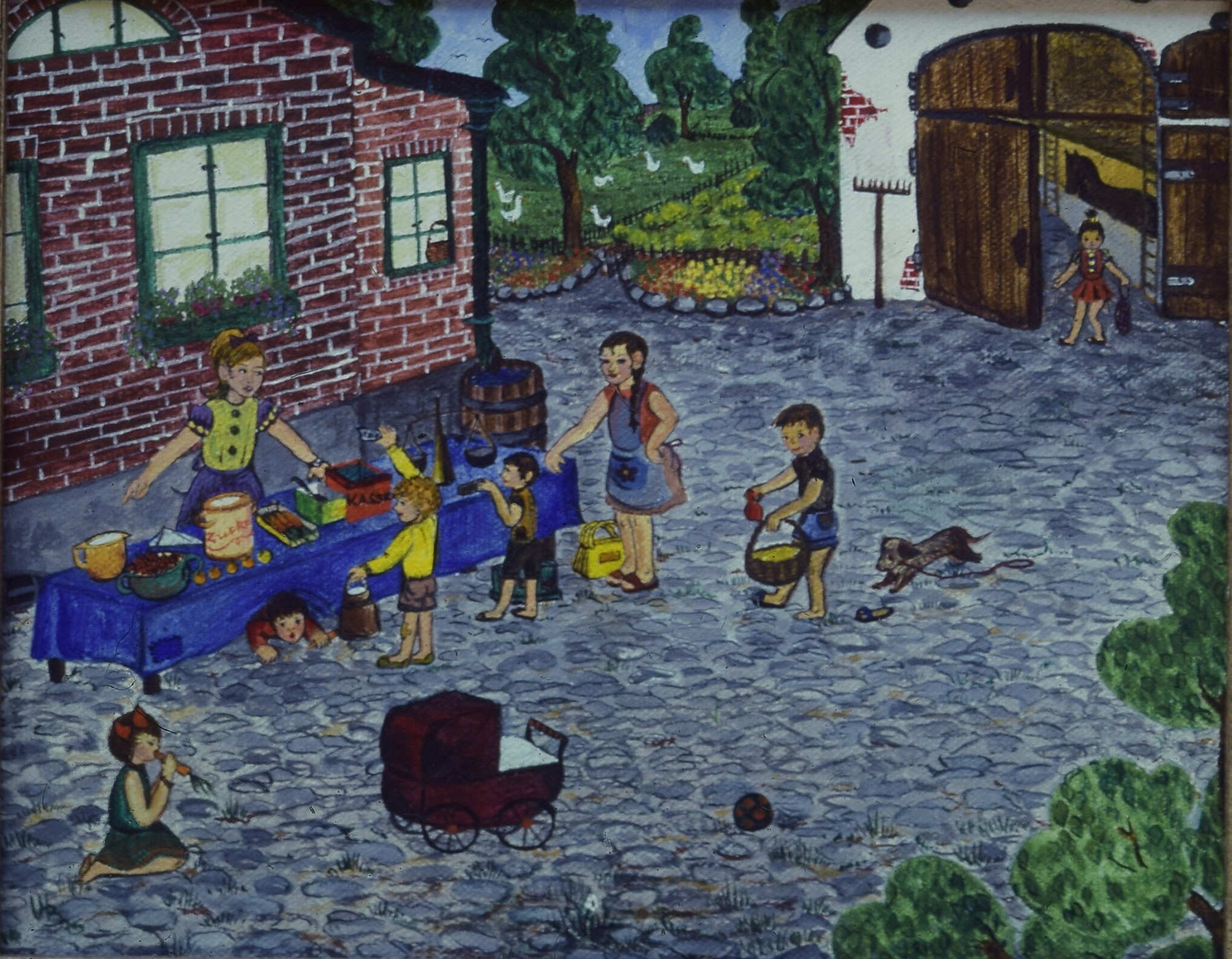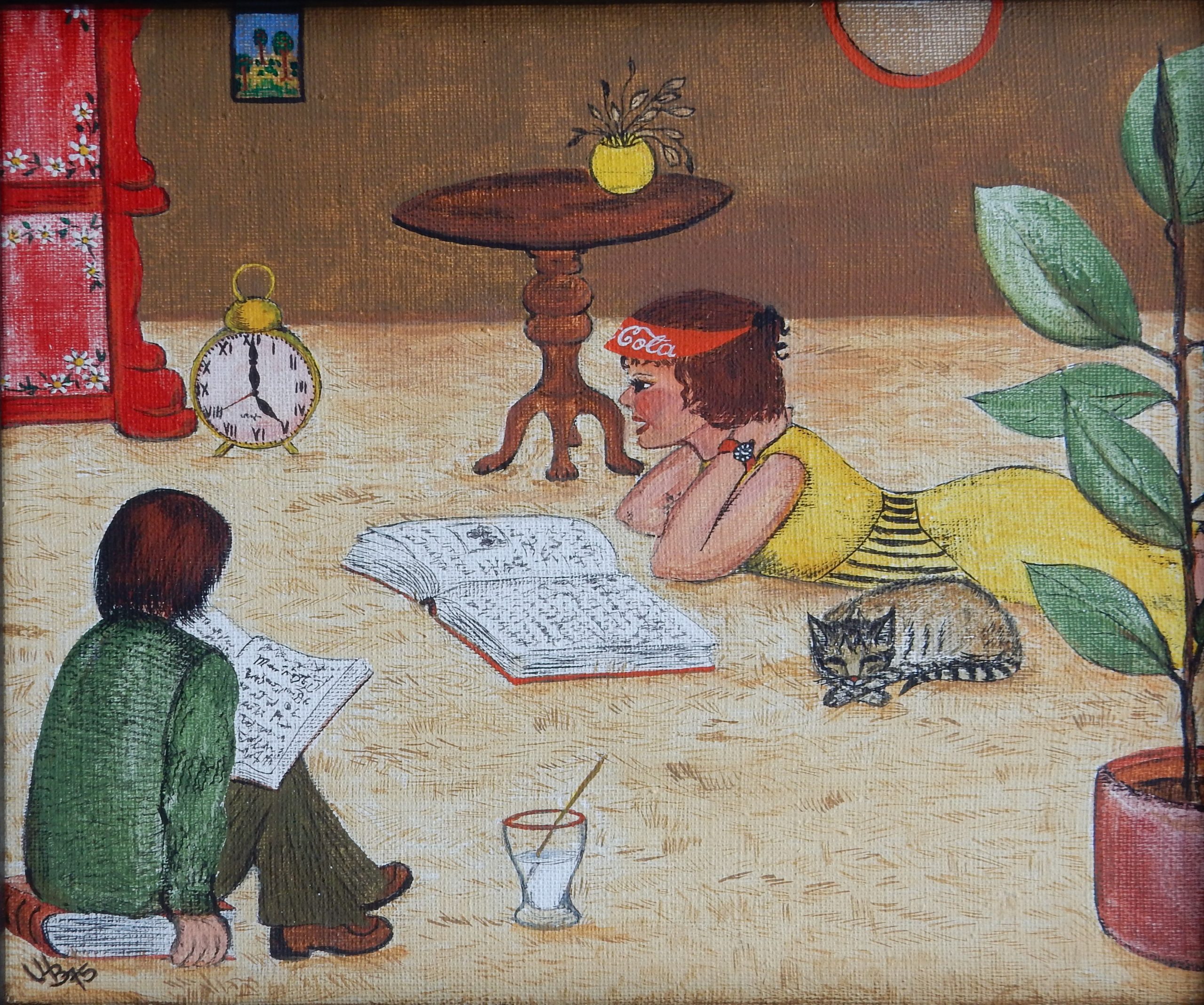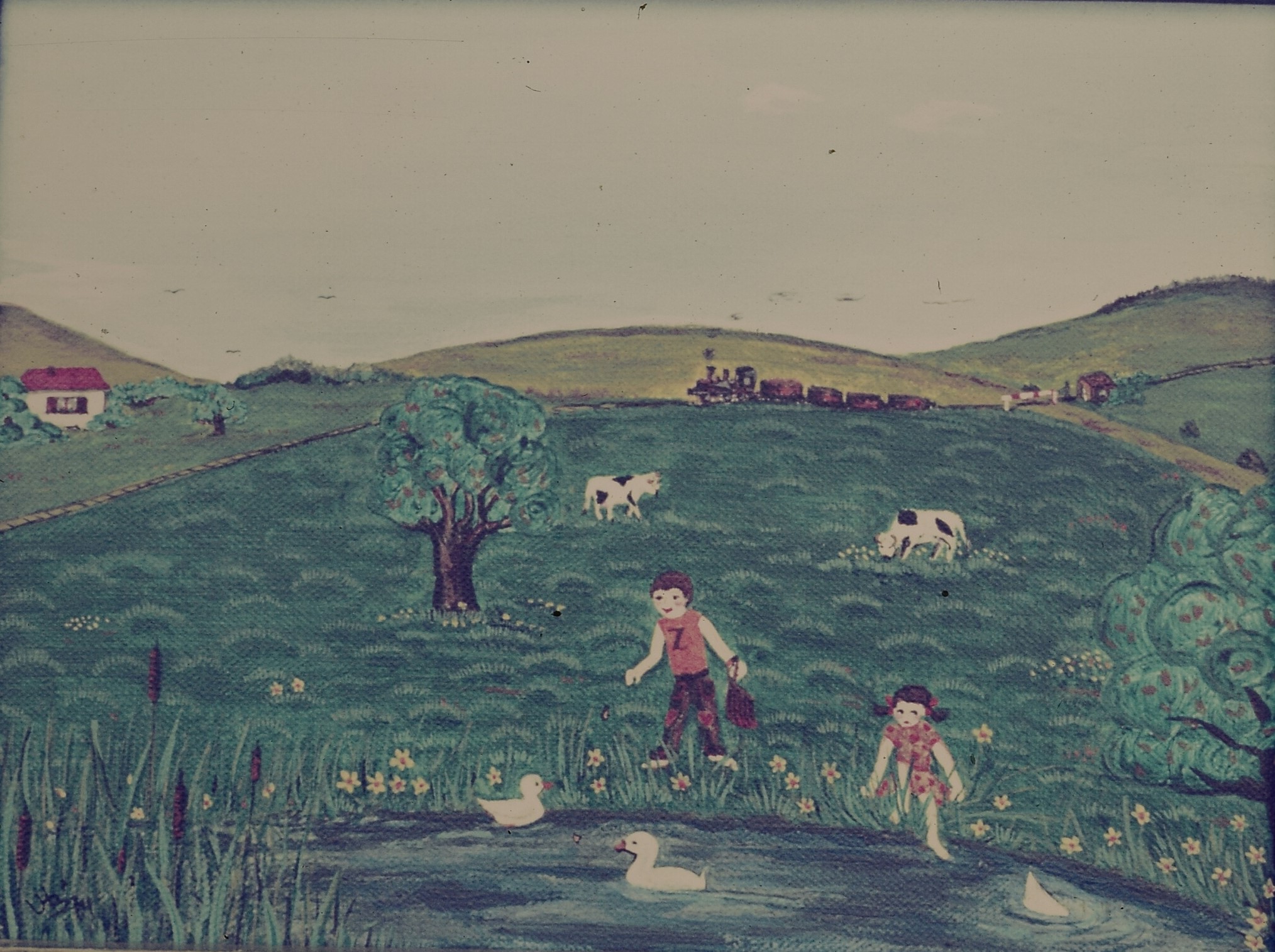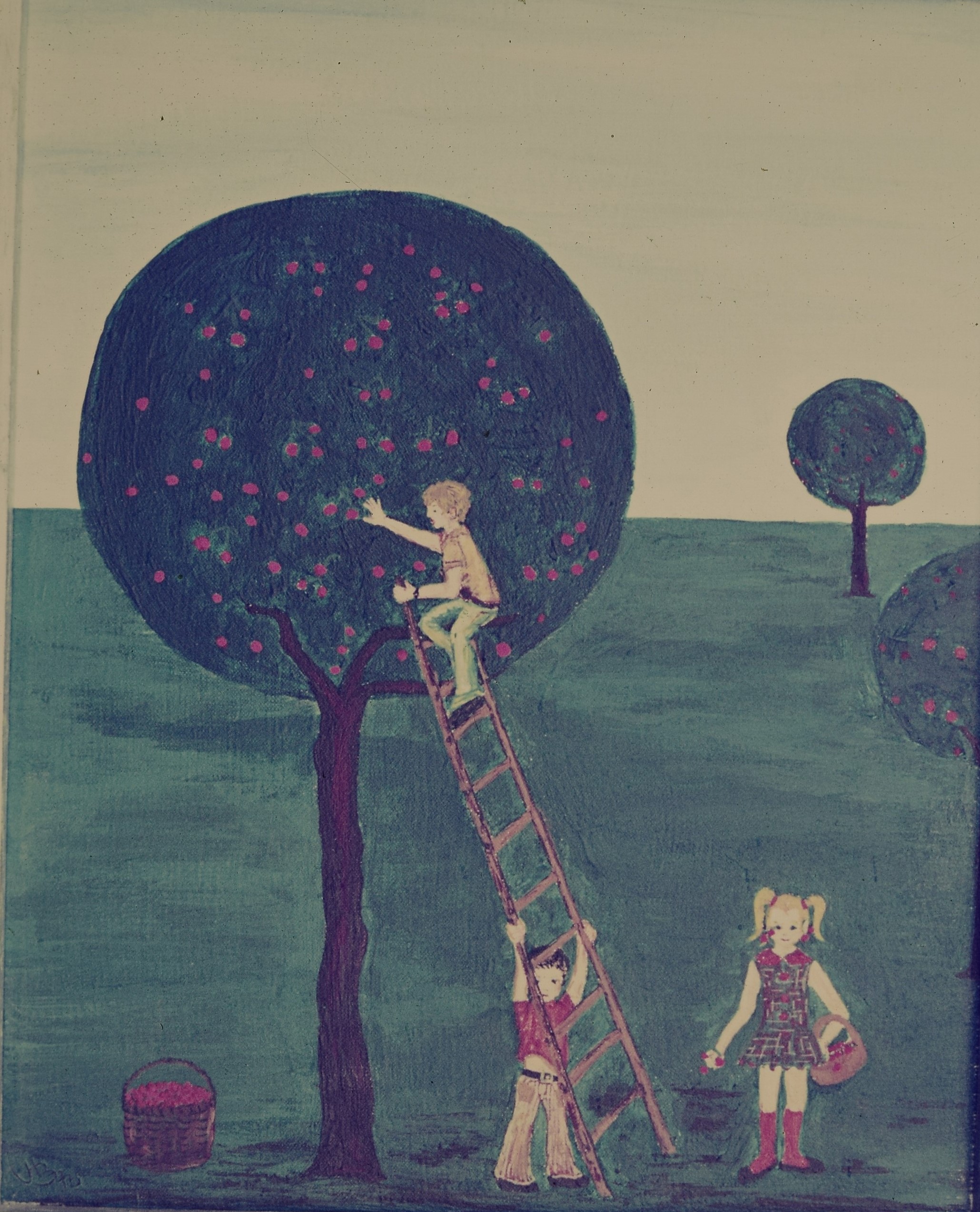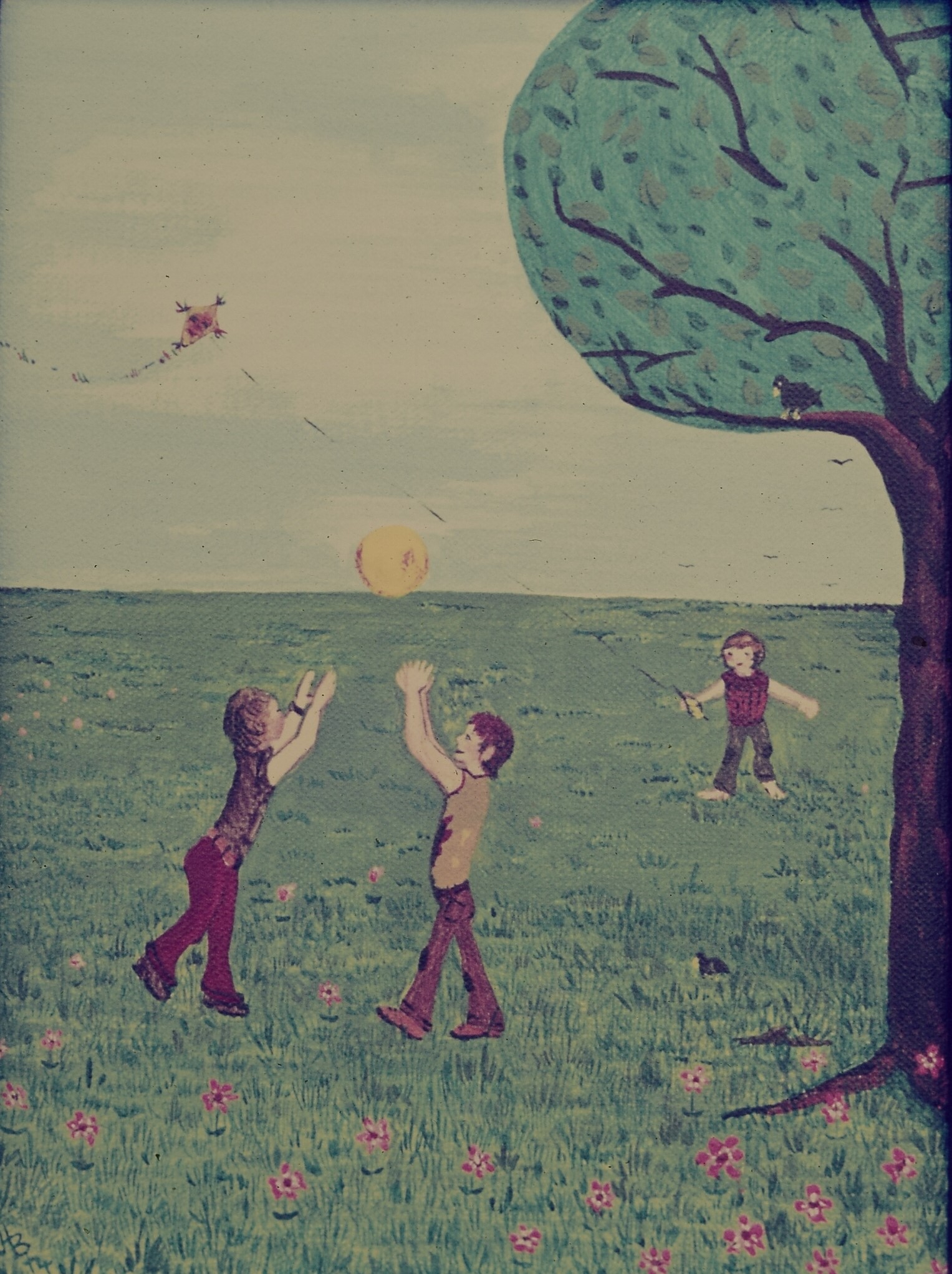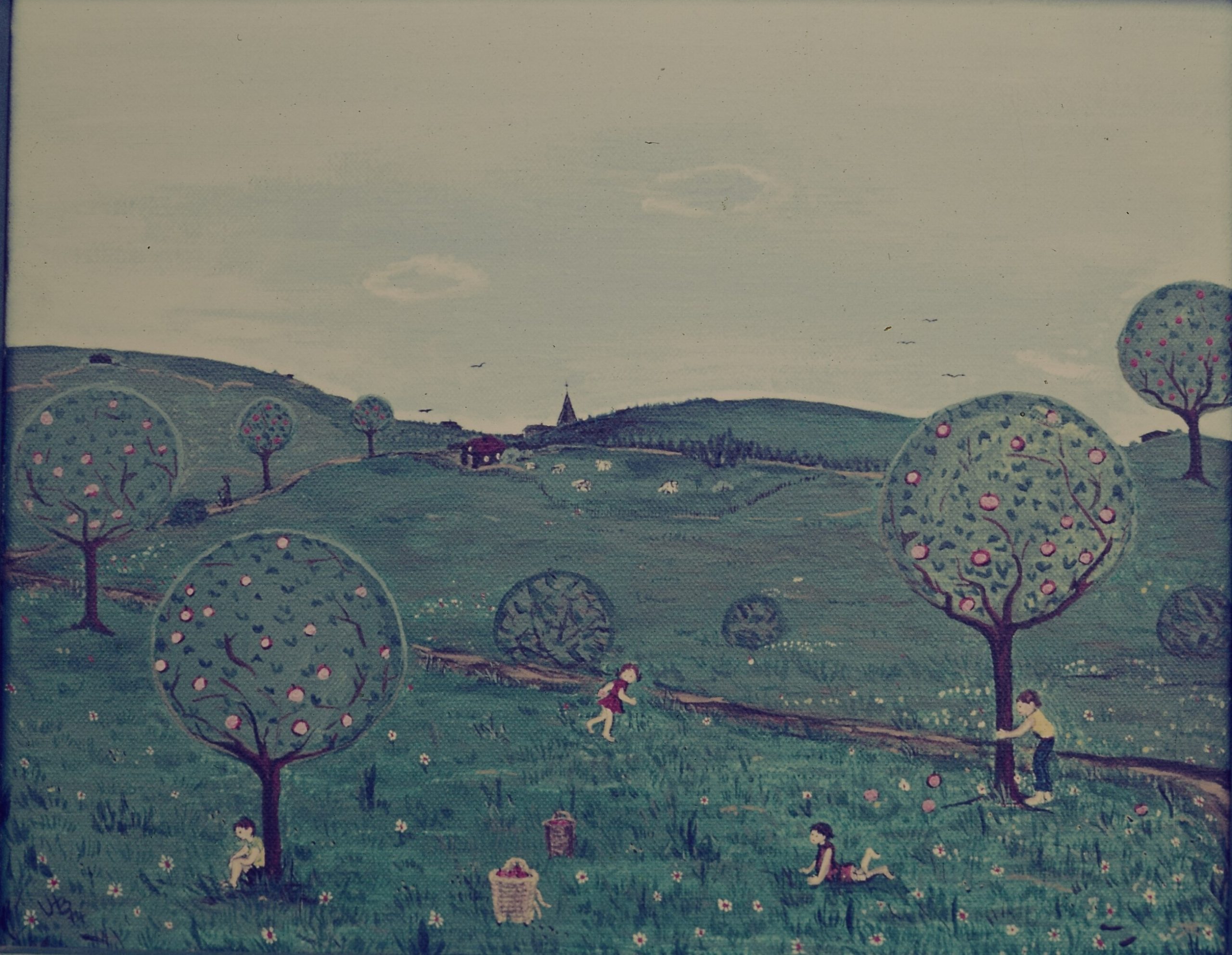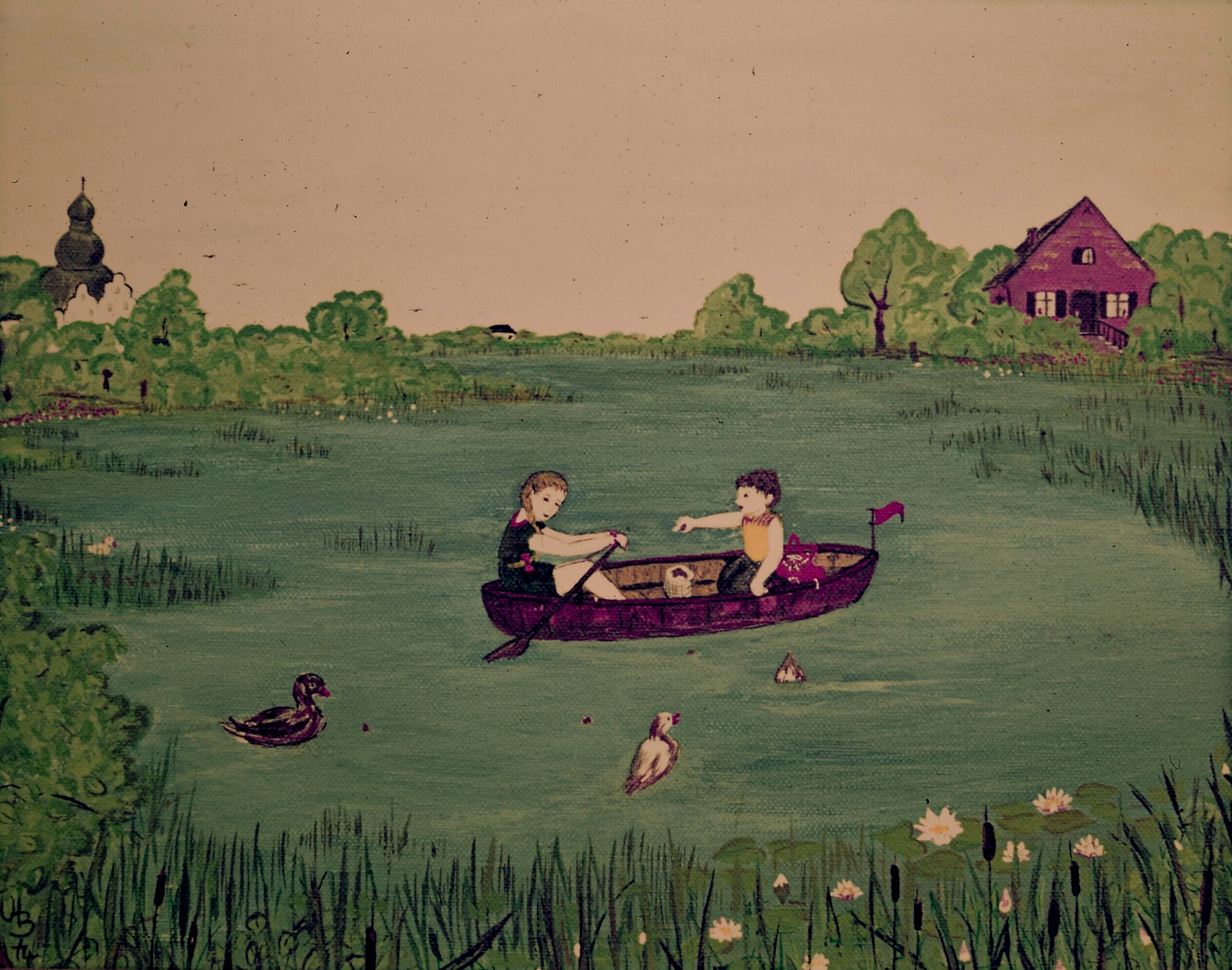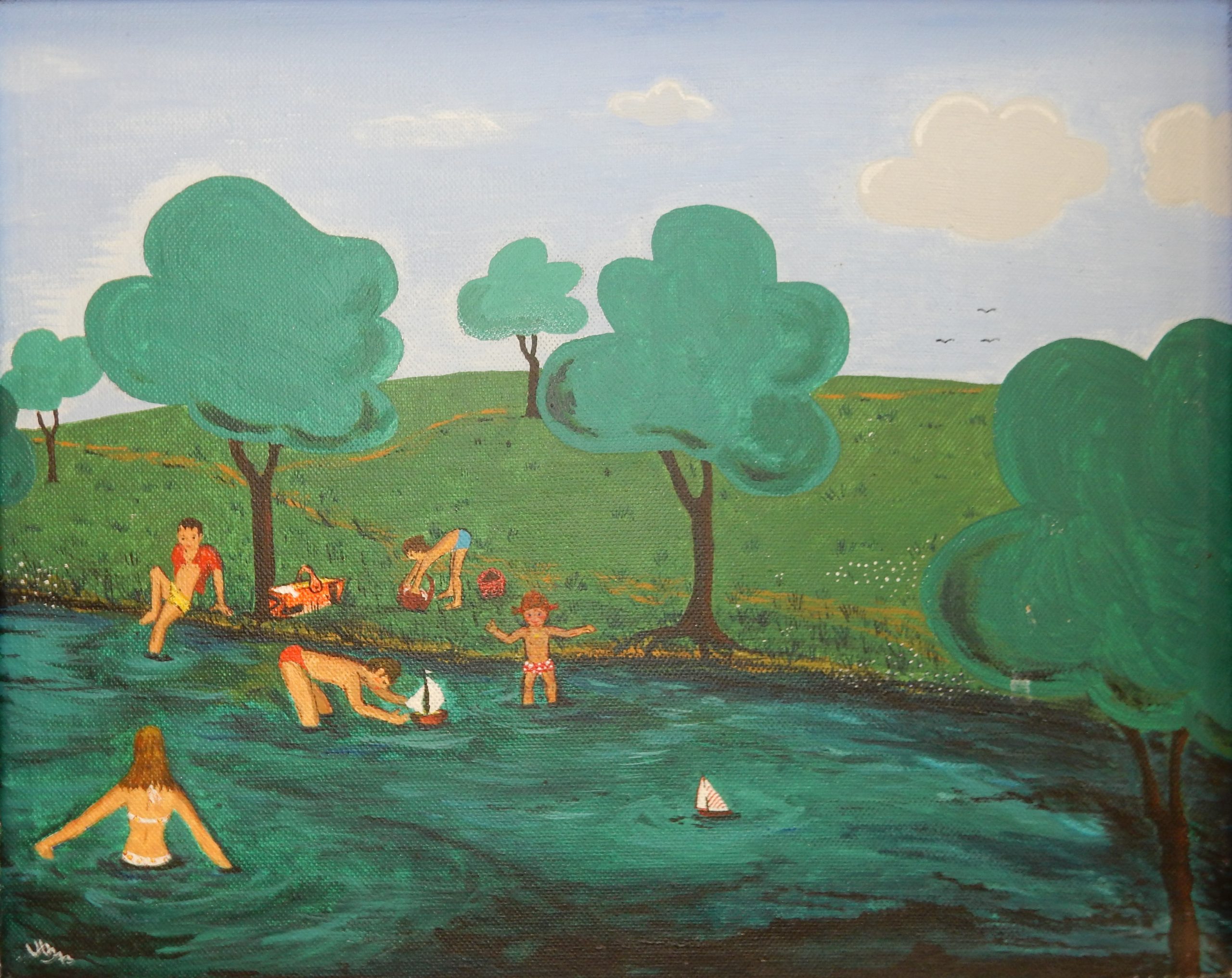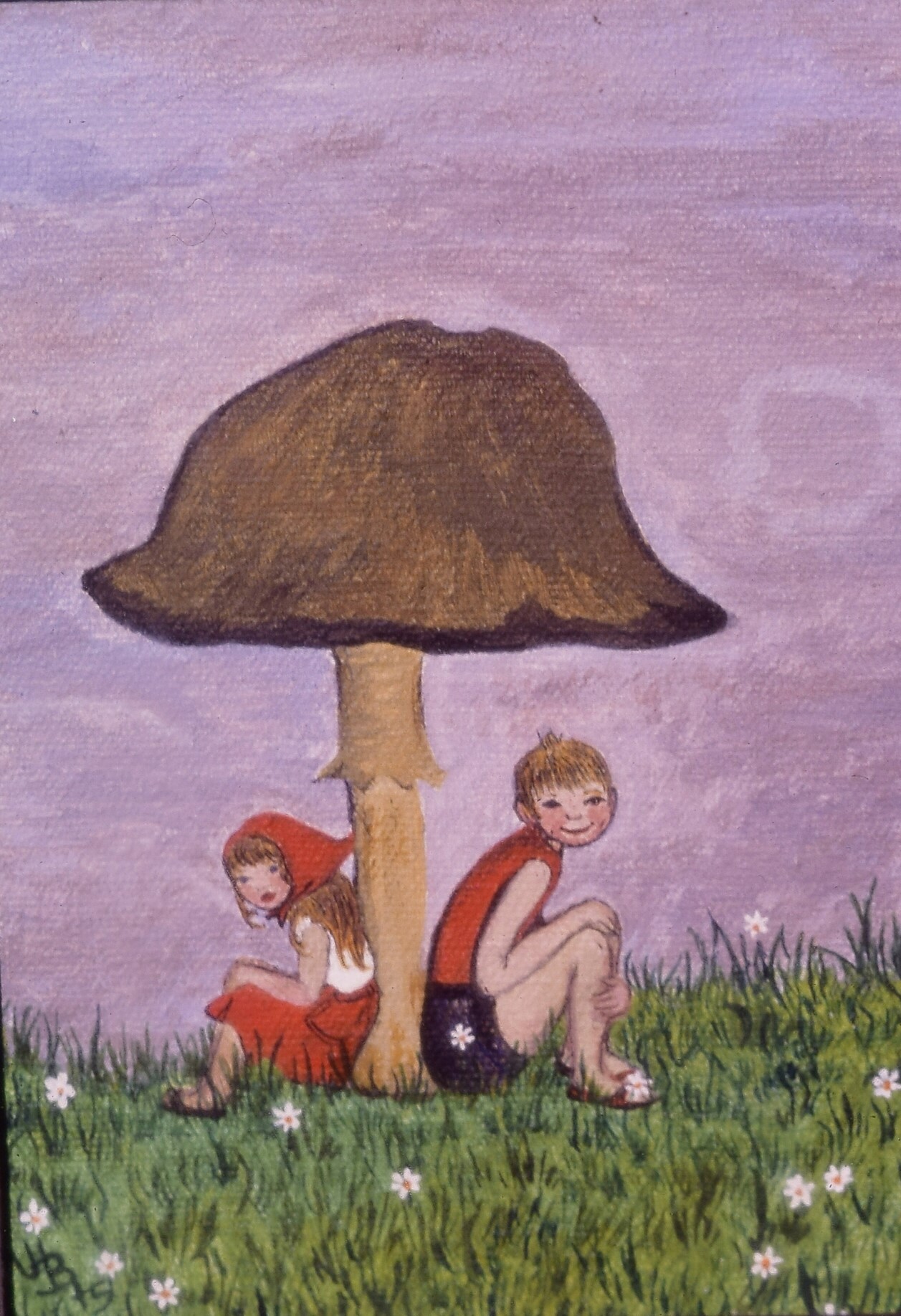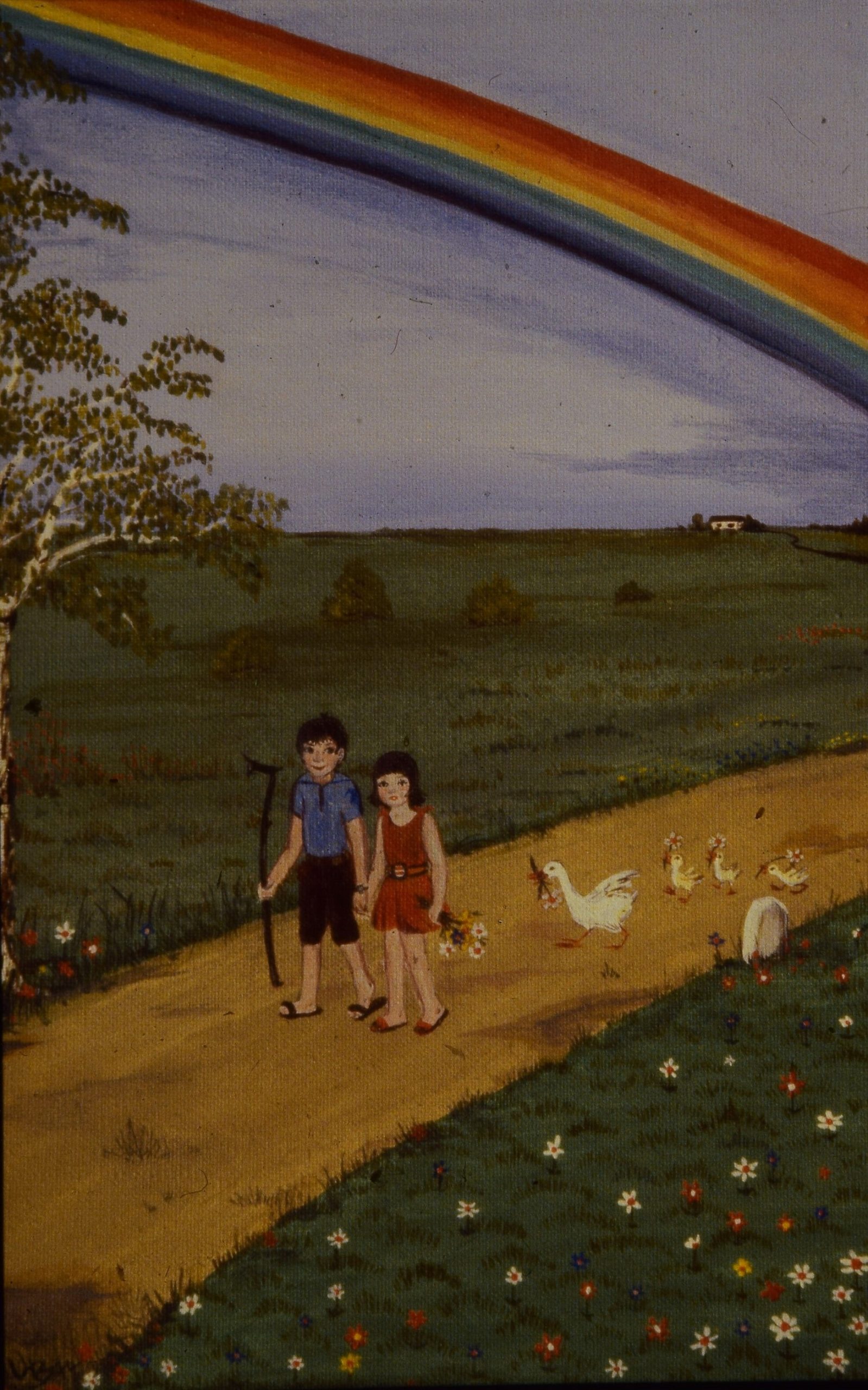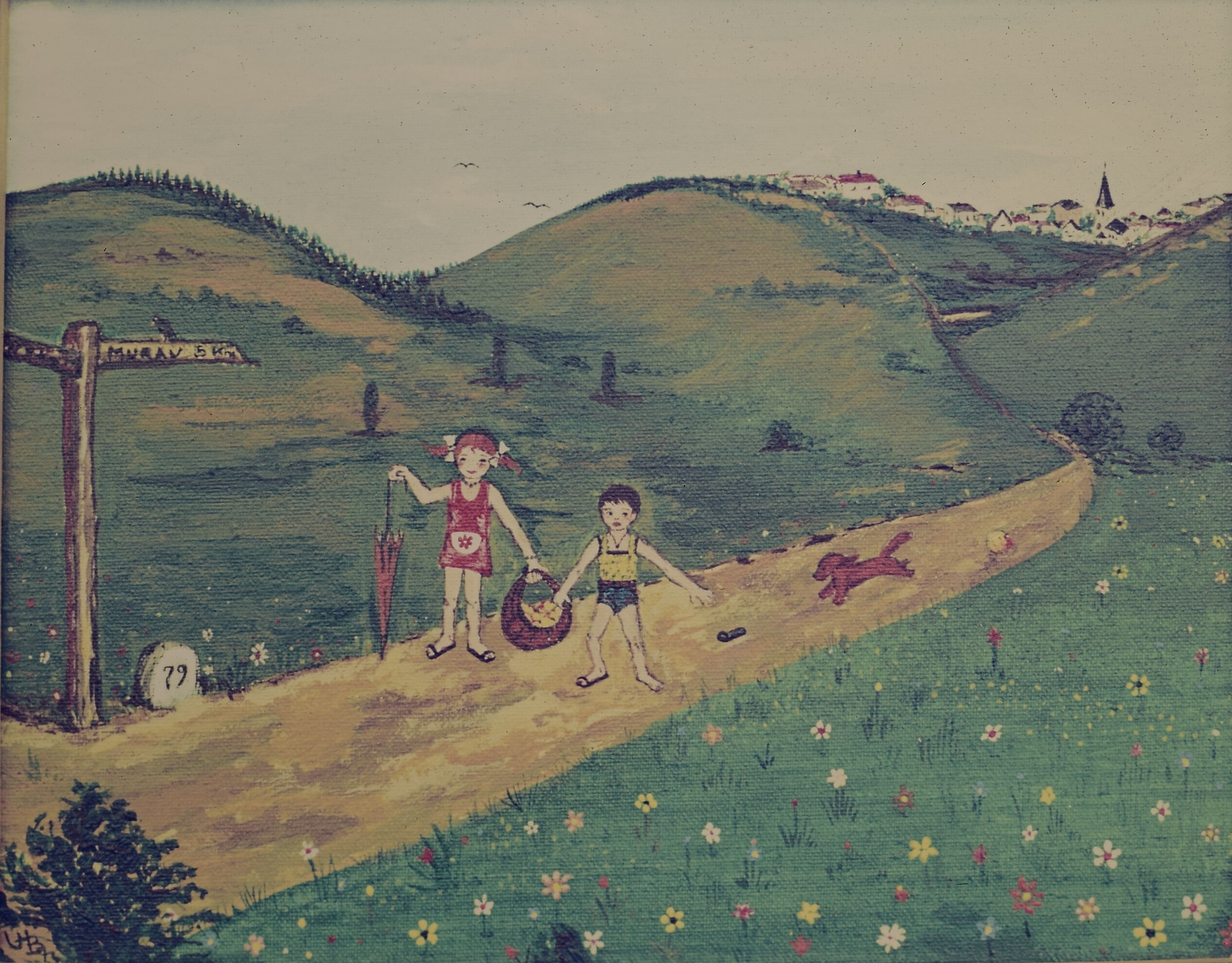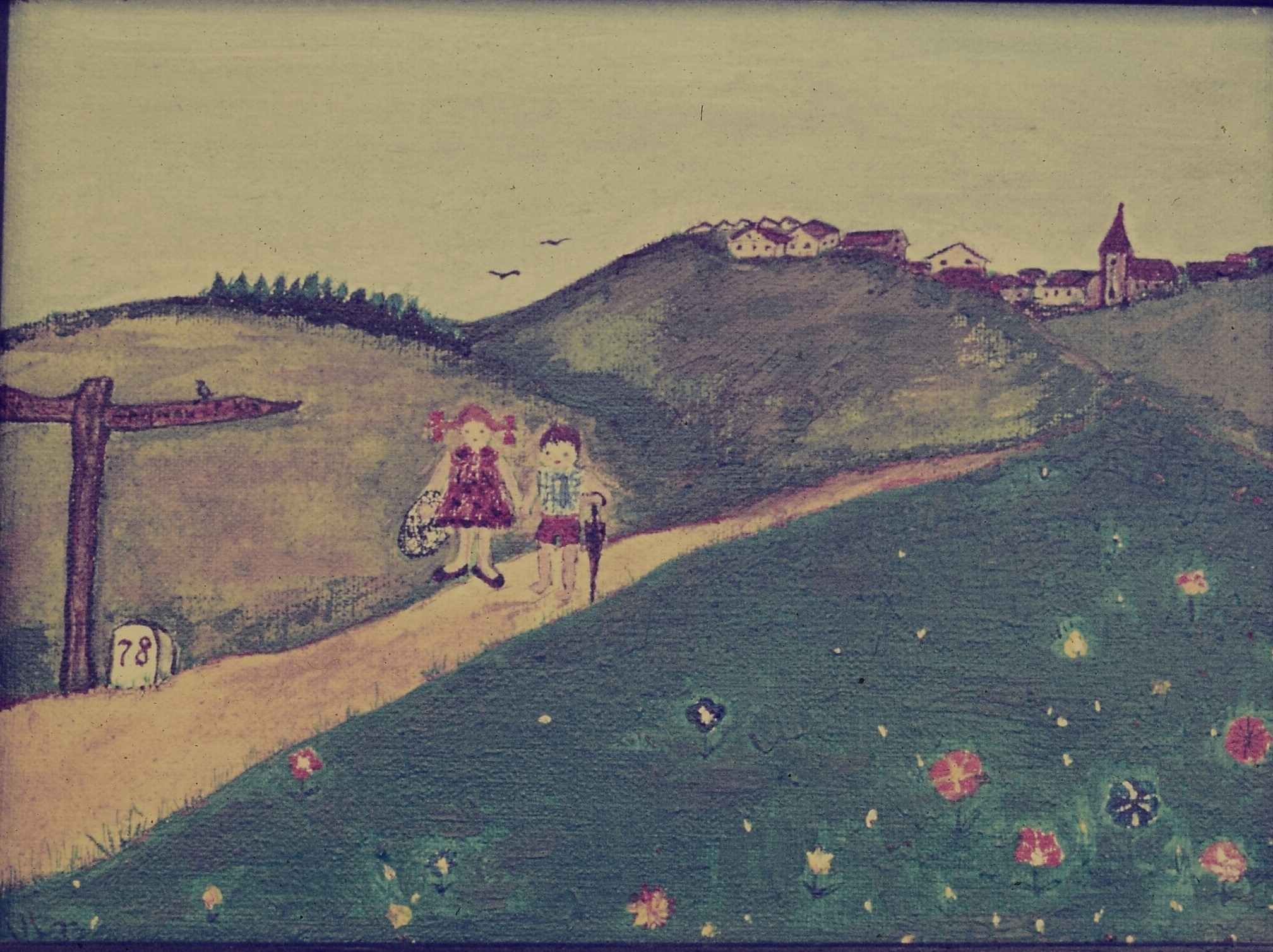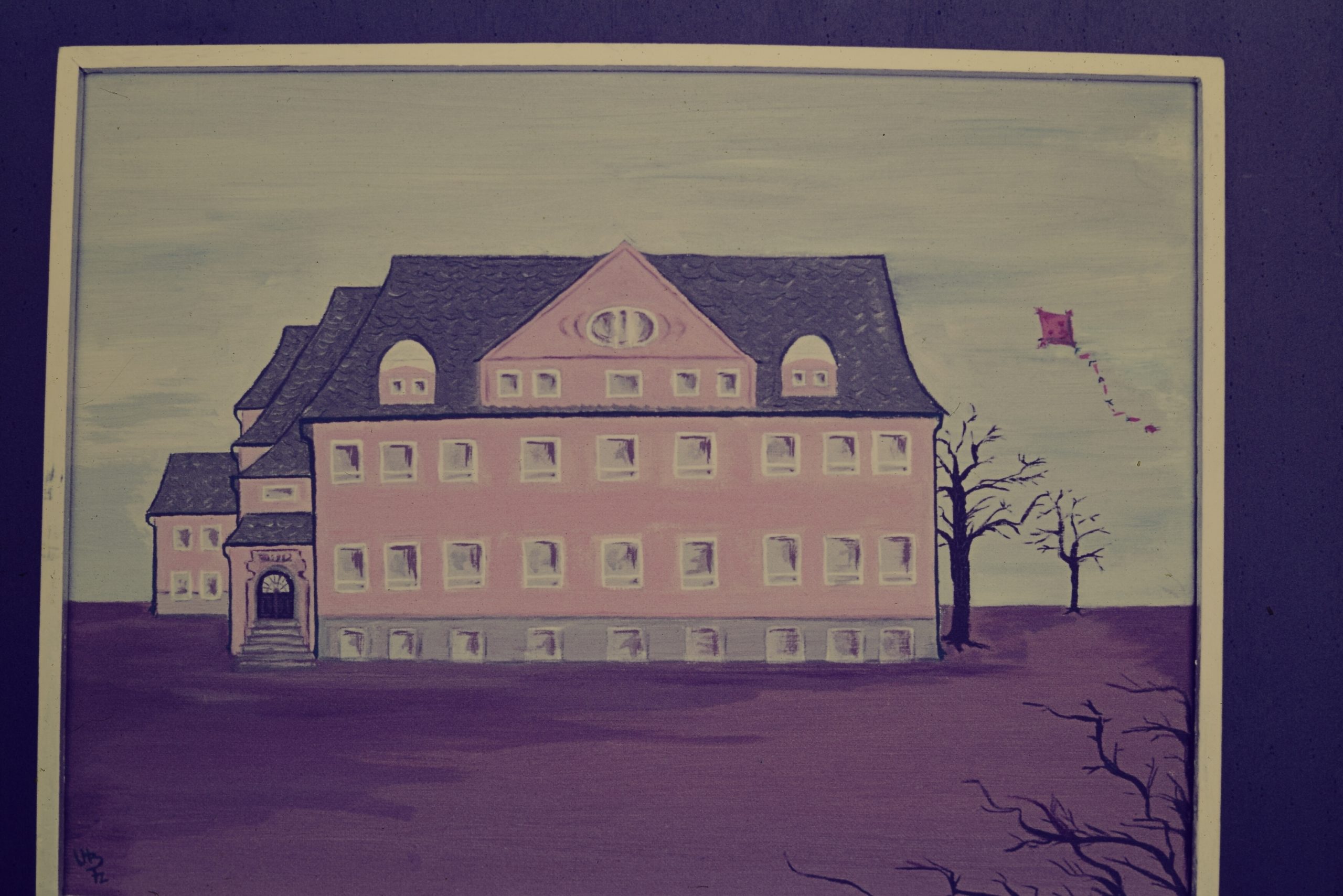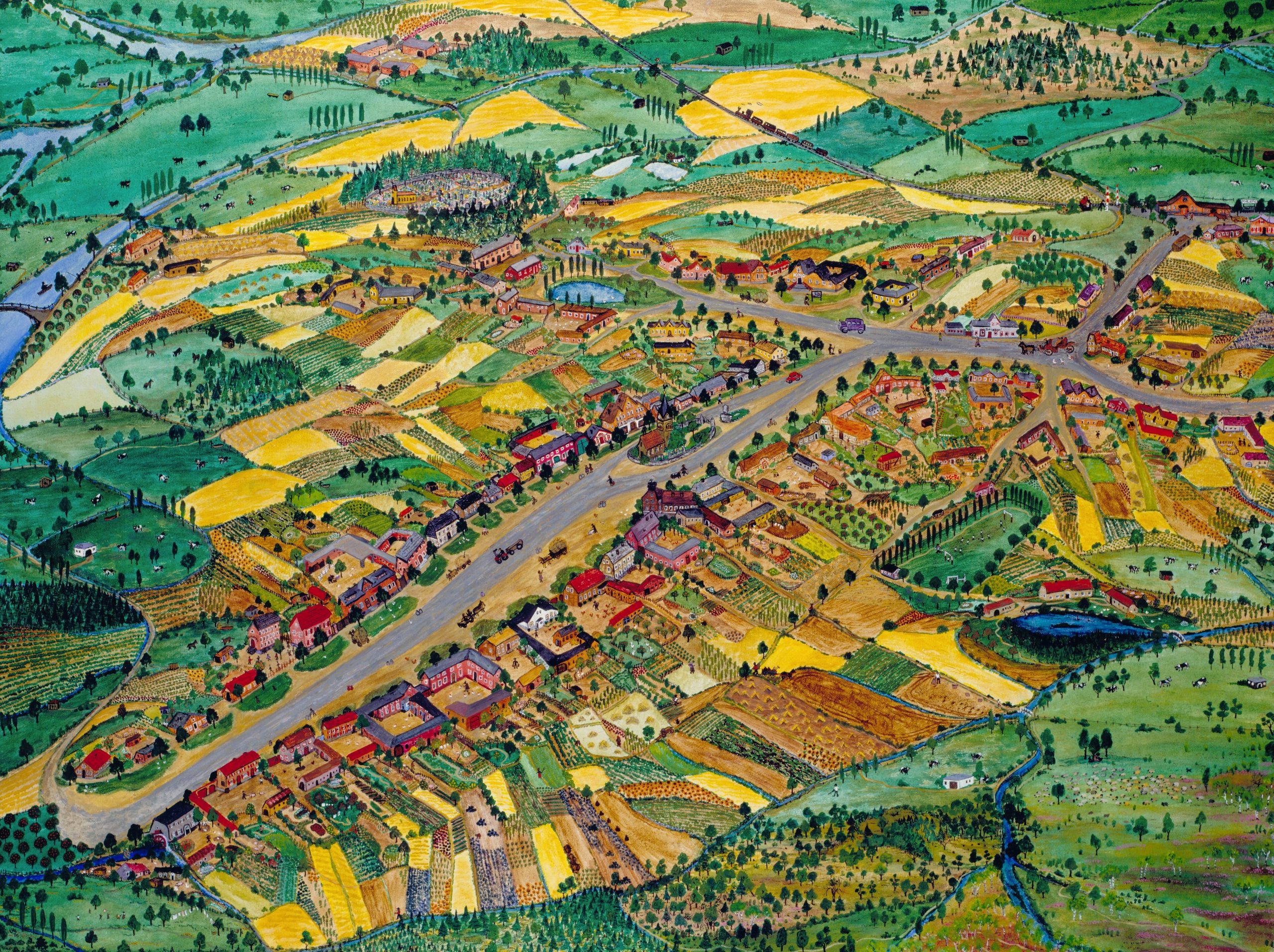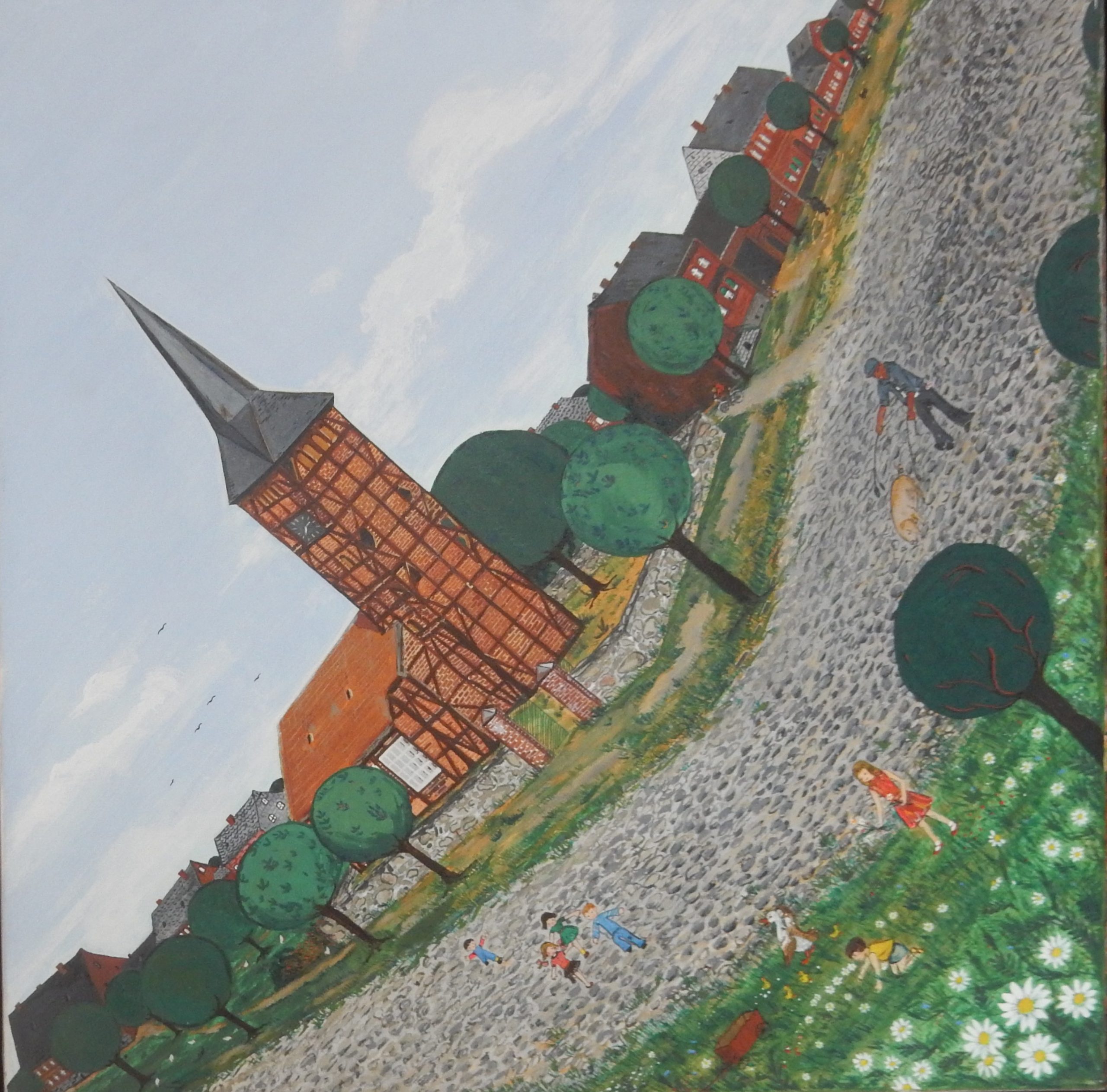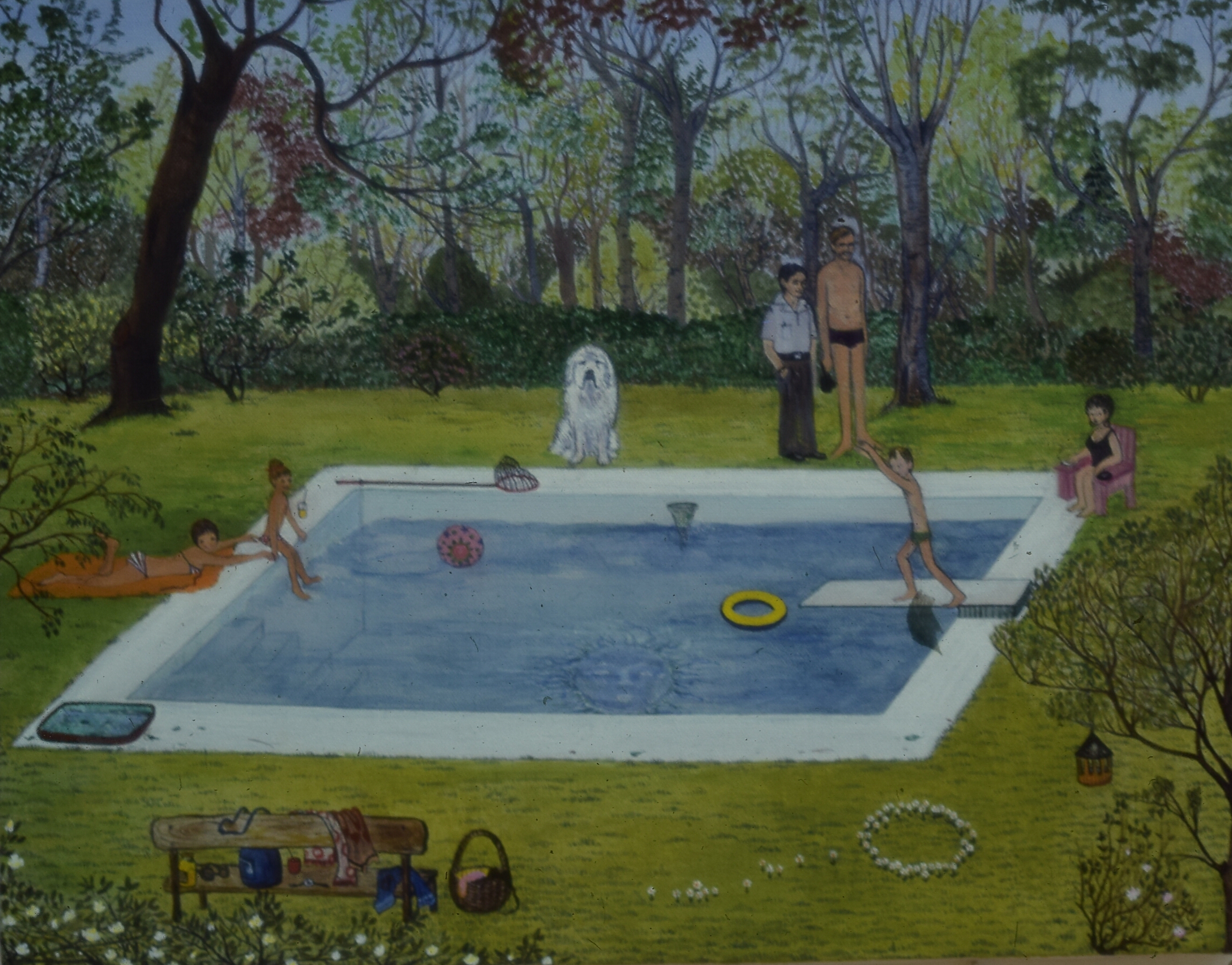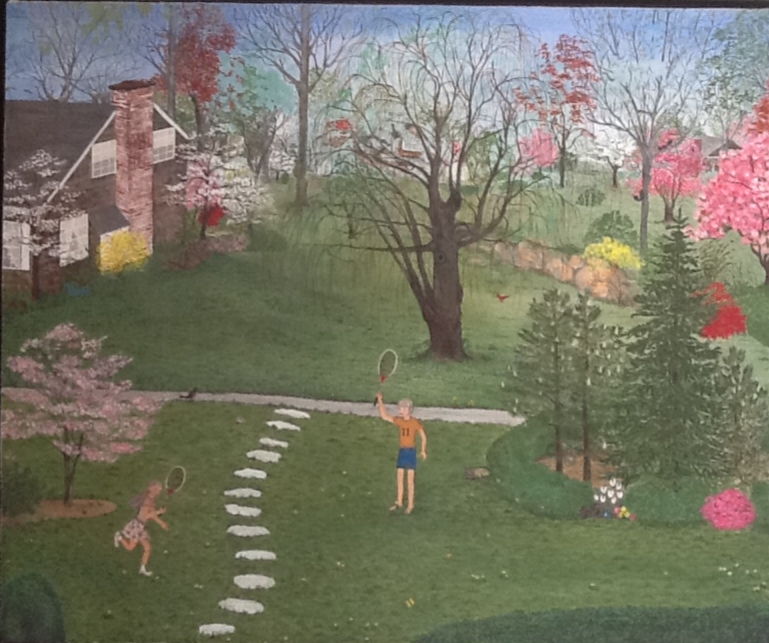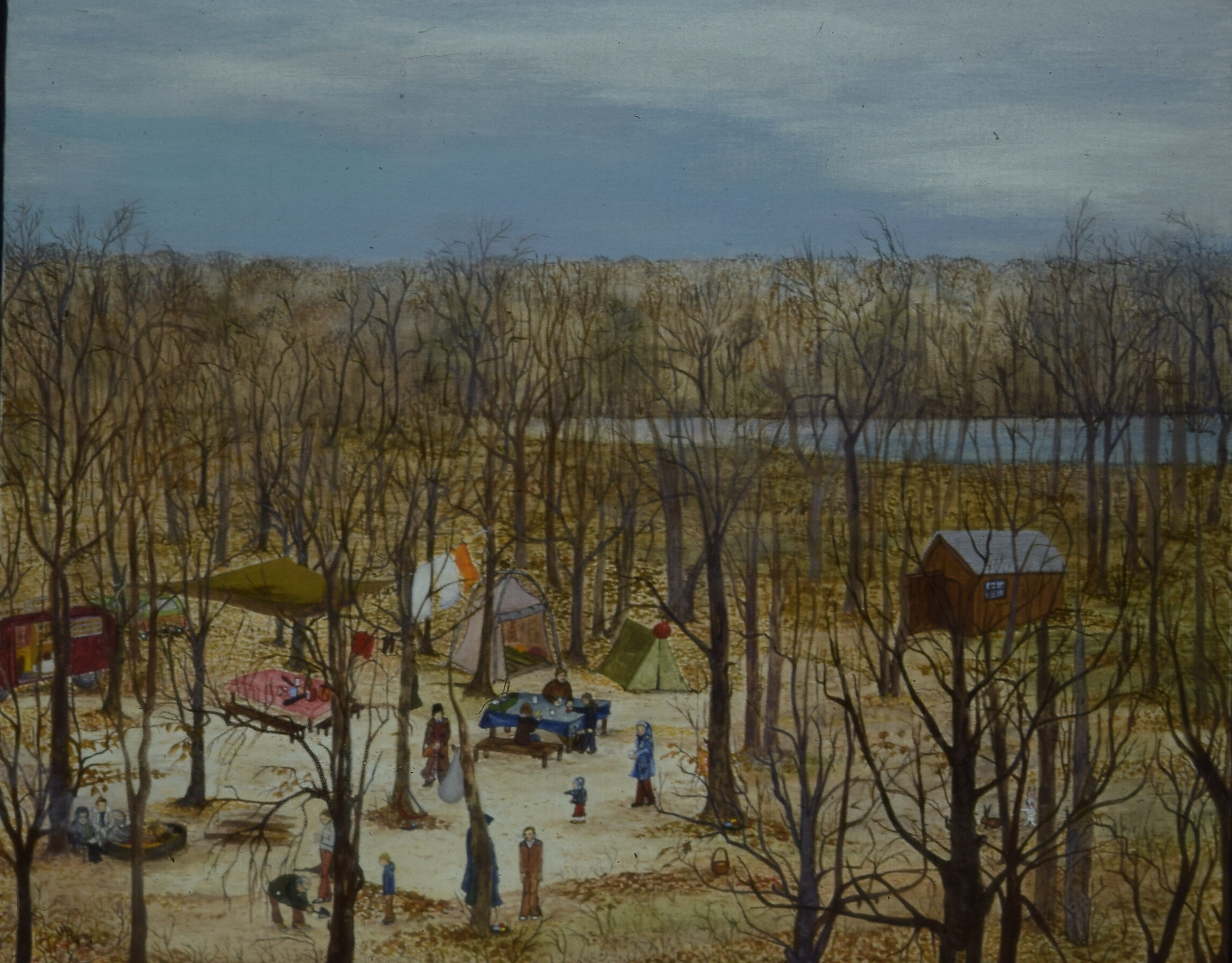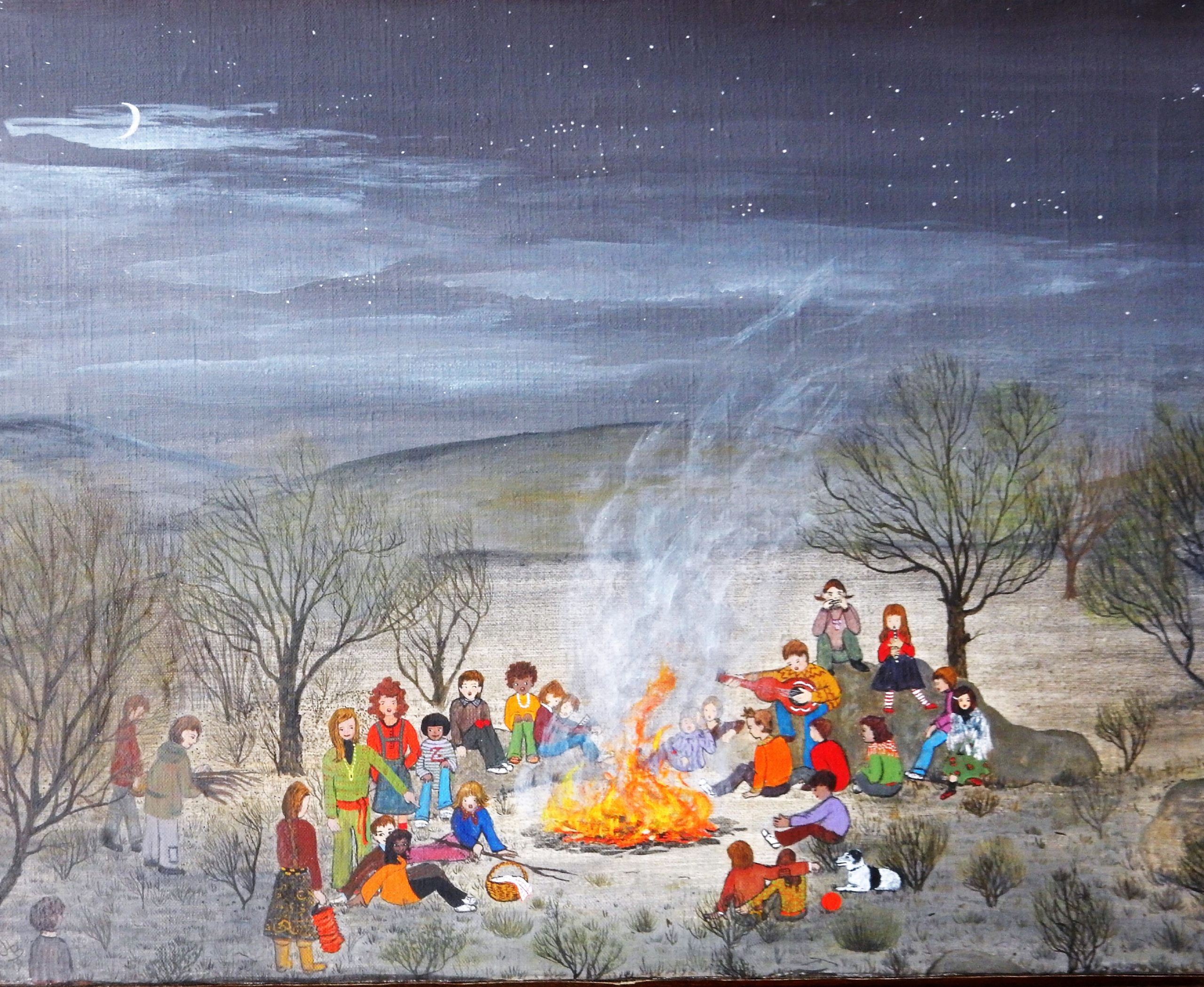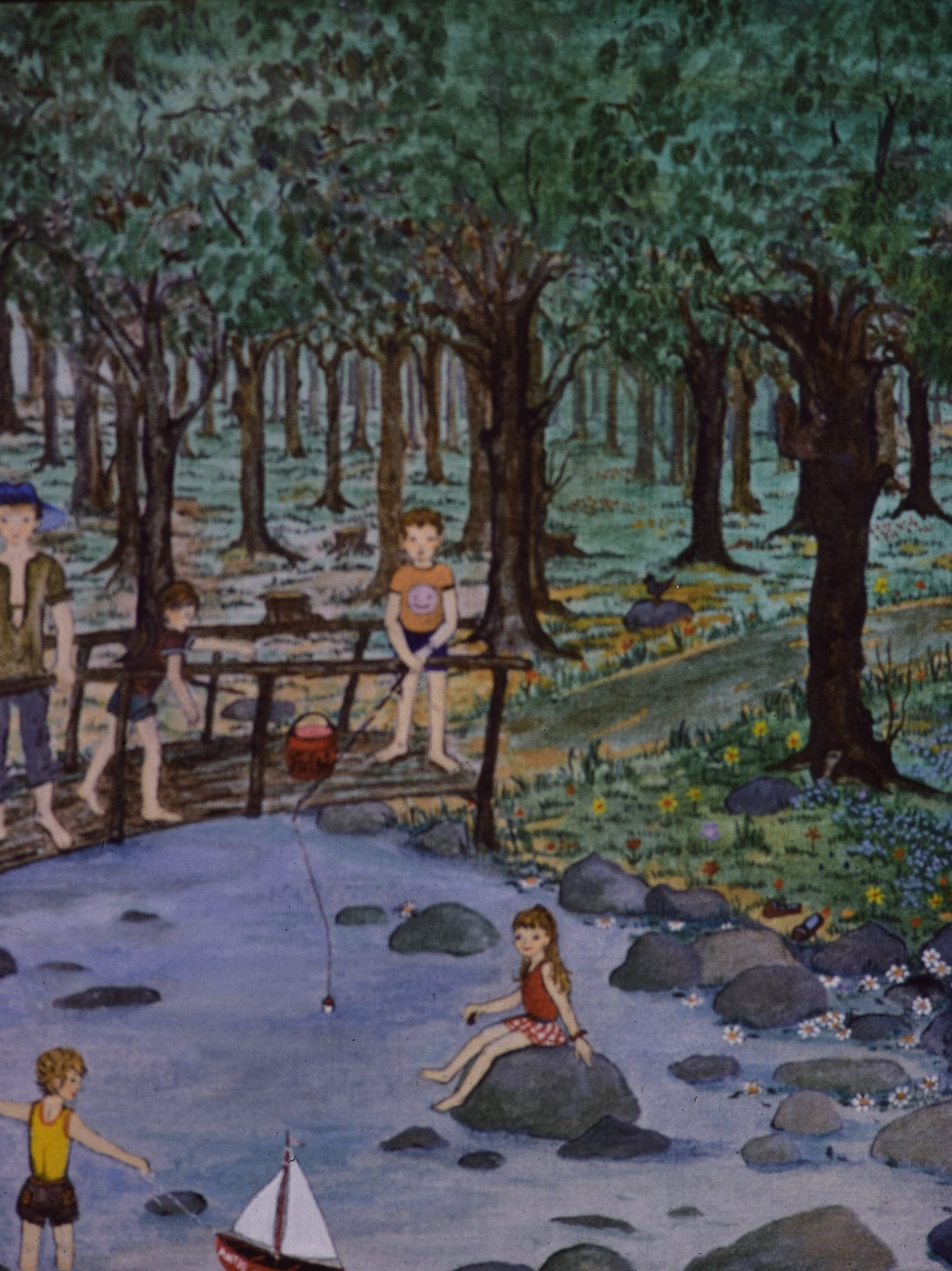Erste Jahre / Naive
Das Fenster (UNICEF-Karte) – 1975 (K1)
Das Fenster (UNICEF-Karte) – Durch ein Fenster sieht man ein spielendes Kind und eine lachende Sonne. Das Bild wurde von UNICEF als Postkarte ausgewählt und später als Grußkarte nachgedruckt. Uta-Heike malte das Fenster absichtlich im kindlichen Stil mit einer Sonne mit Gesicht um anzudeuten, dass diese friedliche Idylle nicht ganz real ist. (24x30cm) Reserviert.
Rosa Schule mit Ballons – 1974 (K2)
Diese rosa Schule gibt es tatsächlich in Kaarst. Erbaut wurde sie 1912. Uta-Heike hat sie mit Luftballons vom Stadtgebiet auf ein großes freies Feld umgezogen, um den Kindern mehr Raum und Freude zu geben. (32x27cm)Verfügbar.
Gartenpavillon – 1973 (K3)
Dieser Gartenpavillon (Tee-Pavillon oder Teehäuschen) liegt im Haus Meer in Meerbusch und wurde 1850 erbaut. Uta-Heike hat es von einer stark befahrenen Straße in einen ruhigen Garten verlegt, in dem nur Kinder über die Mauer klettern dürfen, weil es Spaß macht! (26x32cm) Verfügbar.
Vogel Beerdigung – 1974 (K4)
In Uta-Heikes Kindheit während eines Krieges waren Beerdigungen ein Teil des Lebens. Sie erinnert hier daran, dass sie als Kinder mit großer Zeremonie sehr feierlich tote Vögel begraben haben. (26x16cm) Verfügbar.
Weihnachtsabend – 1975 (K6)
Ein Heiligabend während des Krieges in dem kleinen Dorf Mieste. Die Szene wirkt fröhlich wirkt, zeigt aber ein Weihnachten ohne Väter, da die meisten verwundet, in Gefangenschaft oder vermisst waren. Uta-Heike und ihre Schwester singen Weihnachtslieder, die Geschenke waren in Wirklichkeit viel bescheidener, und die Stimmung war sicherlich viel trauriger. (31x39cm) Verfügbar.
Junge am Fenster -1974 (K8)
Uta-Heike nannte dieses Bild Jungen am Fenster. Es zeigt ein unordentliches Kinderzimmer mit zwei Kinden im Bett. Uta-Heike wollte immer einen Bruder. In diesem Bild erweckt ein altes Märchen zum Leben, in dem man Zucker auf die Fensterbank streut, um seine Träume anzulocken. (30×38) Verfügbar.
der Mensch und das Buch – 1975 (K10)
Uta-Heike hat das Bild „Oma Ida liest“ für einen Wettbewerb „Mensch und Buch“ des ECON-Verlags (Frankfurt) gemalt. Es wurde 86er von 1200 Bildern aus ganz Deutschland. Wie auch im Garten (K9) hat die Künsterin die gütige Großmutter idealisiert. Die Realität in Kriegszeiten war ganz anders. (33×26) Verfügbar
Drei Mädchen mit Katzen – 1973 (K12)
Dieses kleine Frühlingsbild mit drei Mädchen und drei Kätzchen zeigt Uta-Heike’s Idee der kindlichen Lebensfreude. (30×38) Verkauft.
Fahrt auf dem Heuwagen – 1973 (K13)
In Uta-Heikes Kindheit war eine Fahrt mit dem Heuwagen etwas ganz Besondere. Sie fand es toll, von oben auf dem Heu in den Himmel schauen zu können. Die Wolken und Baumwipfel faszinierten Uta-Heike schon als Kind. Aber es war selten, denn wenn der Heuwagen schon zu hoch beladen war, mussten die Kinder laufen. Verkauft.
Garbenhäuschen – 1973 (K14)
Die Kinder spielten gerne Verstecken in den Garbenhäuschen, wo das Heu zum Trocknen aufgestellt war. Auch das war verboten, denn diese wurden oft umgekippt. Aber, Uta-Heike erinnert sich, dass sie es trotzdem immer wieder gemacht haben. (26×20) verfügbar.
Kühe Hüten -1973 (K16)
In den Ferien hüteten die Kinder oft Kühe auf einer entfernten Weide: Sie wurden morgens mit dem Pferdewagen hinausgefahren, aßen mittags „Schlackenbrote“ und verbrachten den Tag damit, aud die Kühe aufzupassen und Pilze zu suchen. Am Abend wurden sie mit den Milchwagen nach Hause gefahren. Verkauft
Bollerwagen – 1975 (K18)
Wie auch die reitenden Kinder (K17) malte Uta-Heike ihre eigenen Kinder in einer Situation, in der sie selbst gerne gelebt hätte. Es zeigt den Bauernhof im Jahr 1973 mit Kindern, die mit Bollerwagen spielen. 26×20 Verfügbar.
Osterreigen – 1974 (K19)
Die Osterfeier malte Uta-Heike in Ihrem ersten Frühling in New York. Das Bild ist voller Freude und Leben. Die Kinder spielen fröhlich Reigen und sogar die Stiefmütterchen wollen mittanzen. Die Osterkörbchen füllen sich von selbst und in den Bäumen kann man das pulsierende Leben spüren. Verkauft.
Schneemann – 1973 (K20)
Oft zeigen Uta-Heike’s Bilder Gutes und Schlechtes zusammen. Hier sind es glückliche Kinder die einen Schneemann bauen. Wenn man genau hinguckt, lauert Gefahr, der erste Schneeball wird gleich geworfen und der Schneemann steht kurz davor, wieder zerstört zu werden. Verkauft.
St. Martinszug – 1975 (K21)
Dieses Bild zeigt einen St. Martinsumzug, Kinder gehen singend mit Ihren Laternen von Tür zu Tür. In Uta-Heike’s Kindheit gab es ähnliche Nikolausumzüge, bei denen sie oft zu schüchtern war, vorne zu stehen, wo die Süssigkeiten verteilt wurden. Dieses Gemälde wurde von UNICEF für das Bildarchiv ausgewählt. Verkauft.
Welcome Sunshine- 1975 (K22)
Uta-Heike nannte dieses Bild „Welcome Sunshine“ . Es zeigt Ihre Begeisterung, dass der Winter vorbei war und endlich Frühling und schönes Wetter da war. Gemalt wurde es nach einem langen Winter im ersten Jahr in New Yorck USA. Verkauft.
Ballspiel im Hof – 1974 (K24)
Dieses Bild zeigt Kinder, die fröhlich einen Ball gegen ein Tor werfen. In Wirklichkeit machte das so viel Lärm, dass sie bald weg geschickt und gebeten wurden, woanders zu spielen. Verkauft.
Auf dem Heuboden – 1973 (K25)
Dieses kleine Bild zeigt Kinder, die fröhlich von einem Heuboden ins Heu springen. Es war wieder eine gemischte Erinnerung, da Uta-Heikes kleine Schwester sich bei einem dieser Sprünge stark verletzt hat. Zum Glück gab es keine bleibenden Schäden, aber Ärger natürlich schon! Verkauft.
Kinderhochzeit – 1975 (K26)
Die Mädchen spielten oft und gerne „Hochzeit“. Aber nur die kleinen Jungs konnten sie zum Mitspielen überreden. Verkauft.
Lesestunde – 1975 (K28)
Einfach in Ruhe lesen dürfen, war für Uta-Heike ein sehr seltenes Vergnügen. Sie hat sich immer zum Lesen verstecken müssen, denn auf einem Bauernhof gibt es immer etwas zu tun, wenn man gefunden wird. 31×26 Verkauft.
Kirschernte – 1973 (K30)
Diese Kirschernte macht Spaß, weil sie ohne Erwachsene stattfindet, die Realität war etwas anders und viel mehr Arbeit. Verkauft.
Apfelernte – 1974 (32)
Diese Apfelernte (wie auch die Kirschernte K30) macht Spaß, weil sie ohne Erwachsene stattfindet, die Realität war ein wenig anders und viel mehr Arbeit. 25×35.
im Wischengraben – 1973 (K34)
Dieser kleine Bach ist nahe des Dorfes Mieste, Uta-Heike hat dort schwimmen gelernt. Der Fußweg dorthin war land und die Kinder gingen nie allein, da der Weg an einem Friedhof vorbeiführte. 32×26 Verfügbar.
das Regenbogenbild – 1975 (K36)
Uta-Heike hat in drei ihrer frühen Bildern (K36,K37,K38) Kinder auf der Wanderschaft zum Thema gemacht. Als Kind träumte sie oft davon, von Zuhause auszureissen. In diesem Bild steht das Wandern untern einem guten Omen, einem schönen Regenbogen. Dieses Gemälde wurde von UNICEF für ihr Archiv ausgewählt. Verkauft.
Kinderpaar Hand in Hand auf Wanderschaft – 1973 (K38)
Uta-Heike hat in drei ihrer frühen Bildern (K36,K37,K38) Kinder auf der Wanderschaft zum Thema gemacht. Als Kind träumte sie oft davon, von Zuhause auszureissen. Dies ist das erste der drei Bildern, es war eines ihrer allerersten Werke mit Akryll auf Leinwand. 26×20. Verfügbar..
Mieste – 1975 (K40)
Dieses wunderbar detaillierte große Bild auf Leinwand gleicht einer naiven Landkarte des Heimatdorfes Mieste von Uta-Heikes. Sie hat es komplett aus ihrem Erinnerungen rekonstruiert. Erstaunlich ist, dass wenn man Mieste googelt, sieht man, wie nah das Bild der Realität ist. (104×79) Verkauft.
Lollos Garten – 1976 (K42)
Uta-Heike malte den Garten ihrer Malerfreundin Lollo Meyer. Das Bild zeigt Lollo, ihren Mann und Hund sowie die ganze Bresser Familie. Wer genau hinschaut sieht die Sonne die Lollo auf den Boden Ihres Pools gemalt hat. Verkauft.
Zeltlager – 1976 (K44)
Camping – Ostern 1975 waren Uta-Heike mit ihrer Familie und einer befreundeten amerikanischen Familie in der Nähe von Atlantik City campen. Es war bitterkalt, aber schön. Ein Jahr später malte sie die Szenerie mit Hilfe von Fotos. Dieses Bild hat sie den Glicks, den Freunden, zum Abschied geschenkt. (38×30) Verkauft.
Segelboot Antje – 1978 (K46)
Die Inspiration für dieses Bild war eine Reise zum Yellowstone National Park in den USA, dies ist der Custer State Park. Uta-Heike hat das Segelboot nach ihrer Schwester Antje benannt. Es war für sie ein Zeichen an ihre kleine Schwester, dass sie sich ihr nun als Erwachsene endlich näher fühlte. 32×40.
